This is Part 4 of 4 of The Alexander Scott Collection article, which has been divided into sections for clarity.
AN IMAGE OF BUDDHA (Fig. 33).—This figure is one of a very rare series of images made at Gaya at least two thousand years ago, in the reign of the great Emperor Asoka. But whether it is one of the original or one subsequently made in the same mould, it is very difficult to tell.
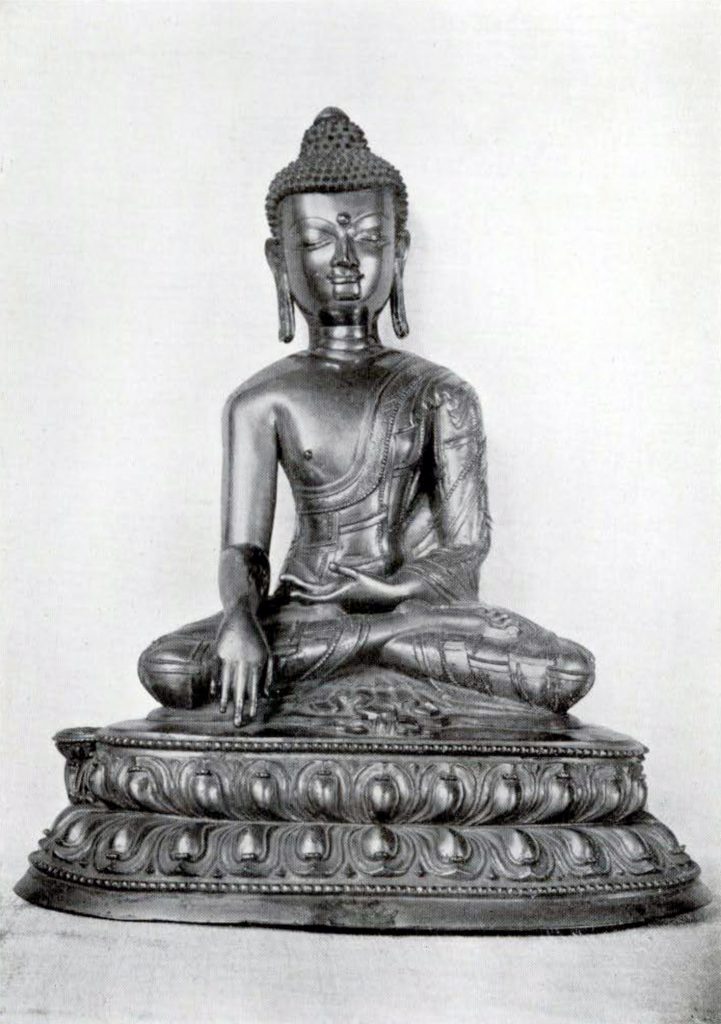
Museum Object Number: A1110
Image Number: 2166
But from the fact of the Dorji on the throne, right in front of the image, and the double throne of lotus petals all round in which respect it is not like any other Tibet or Nepal made images, it is clearly one of those moulded in Gaya. And there is a restriction forbidding it to be copied exactly. Mere copies must have the Padma or lotus throne unfinished, that is, only carried around three fourths of the circumference. Also the patches on the priestly garb are never depicted as minutely in the copies as in the originals.
There are thirty-two signs of auspiciousness upon this image, among them the upraised crown oil the head, the curls of hair which turn always to the right, long and tapering fingers, the whirl of hair on the spot where the eyebrows meet, dark blue eyes, eyelashes like those of a cow (sweeping), even teeth closely set together, possessed of very sensitive and fine palate, cheeks like those of a lion (round), the shoulders very round and gracefully shaped, wide shoulders, both in front and back, fine skin of flesh, the upper portion of the body resembling a lion’s front, the lengthened lobes of the ear, the marks of Chakra on the hands and feet. The possession of this image is said to ensure wealth, fame, prosperity and long life to the possessor.
If we keep this image on the altar in our house and think of how Buddha Gautama Sidhartha (Sakya Muni) lived, how he loved all sentient beings, how he gave up a kingdom for the purpose of seeking a path whereby all might obtain Nirvana, and if we once ponder on the nature of Nirvana to which he aspired, we shall obtain this Nirvana. (No. 1110.)
JETCHÜN MILA REPA (Fig. 34).—This is a likeness of a saint and there are few symbols to explain besides his Yogi’s dress, the skull bowl and the lotus throne, as well as the antelope skin that he sits on. The band that he has on the right shoulder is the meditation supporting band, called Gomthak in Bhutia or Tibetan. He sits in the Sempay Kyilting, or Bodhisattvic Asan posture. The Gomthak is a band used to support the devotee in a particular posture even in sleep.
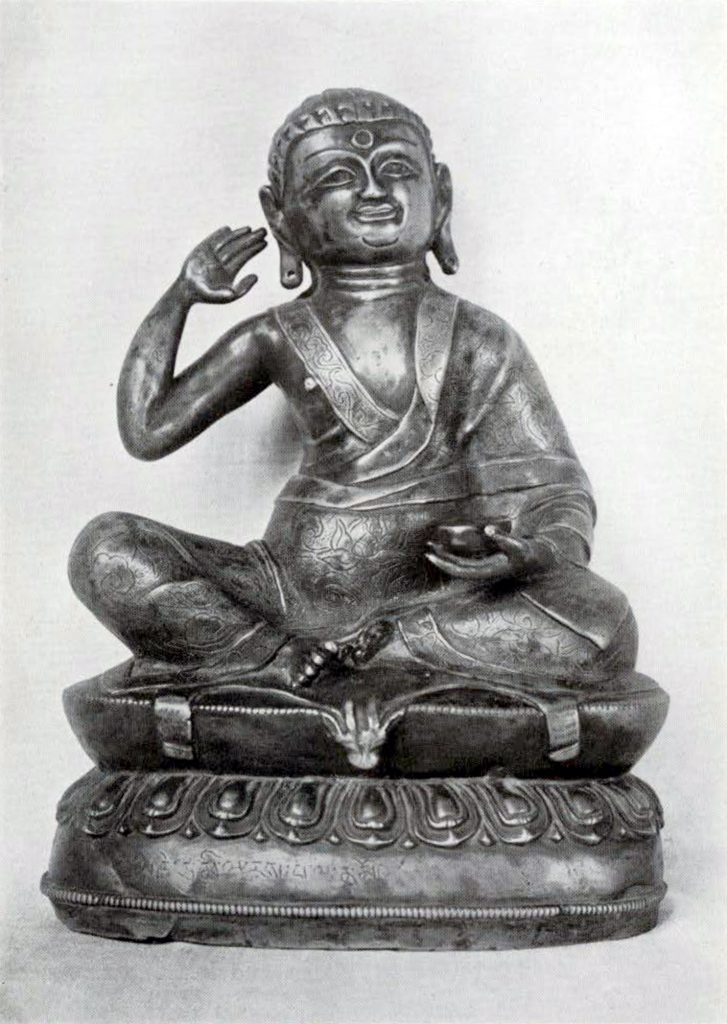
Image Number: 2167
He holds his right hand in the position expressive of reciting his psalms, of which there are a great many. They are quoted by the Buddhists as next to Buddha’s and Padma Sambhava’s sayings in authority. He is represented with the skull bowl from which he used to eat.
Now for a little history of the saintly man himself. He was the son of a well-to-do man named Mila Sherap Gyaltehhan, and his mother’s name was Yiun Myangtchhu Kangyan, of Kyangatcha, on the northern frontier of Nepal, about eight or nine hundred years ago. He was orphaned by the death of his father, who willed :hat his property should be looked after by Mila Repa’s uncle and aunt during his youth and childhood, but restored to him when he came of age, which they never did. Then at last the false trustees fairly undeceived the poor widow and orphan of their intention to rob them of their patrimony. Upon knowing this, Jetchün’s mother sent him to study black magic, by the power of which Jetchün destroyed thirty-five members of his uncle’s and aunt’s family. Repenting afterwards, he sought to make up for his sin by devoting his life to religious studies under Pha Marpa, a disciple of Pal Naropa, who in turn was a disciple of Pal Tailopa and Dorji Chhang. Under Marpa’s guidance and instructions Jetchün obtained initiation and confirmation. After that he lived as an ascetic Yogi in Takar Taso for about eighteen years and for about eighteen years longer on top of Mount Everest called by the Tibetans, Lapchi Kang, and from there, after having obtained supernatural powers, he finally ascended heaven by transfiguration. (No: 1111.)
FIGURE OF NIGÖNPO JEATCHÜN RDORJE ACHHANG (Fig. 35), (pronounced as Gonpo Jetchün Dorja Chhang) in Bhutia, the saint who propagated the present system of Bajrayana doctrine in India about 1200 A. D. He is called Bajra Dhara in Sanscrit, from the fact that he holds the Dorji (thunderbolt) in his right hand, symbol of almighty power, and the Tchebun, or urn of life, in the left, symbol of life eternal. He is the first saint who puts on a Hayruka’s dress, that is the Yogi’s dress: bone ornaments, bone beads on his breast and arms, and a double row of beads crossed round his breast with a Mehlong or mirror, meaning the power of reading thoughts clearly.
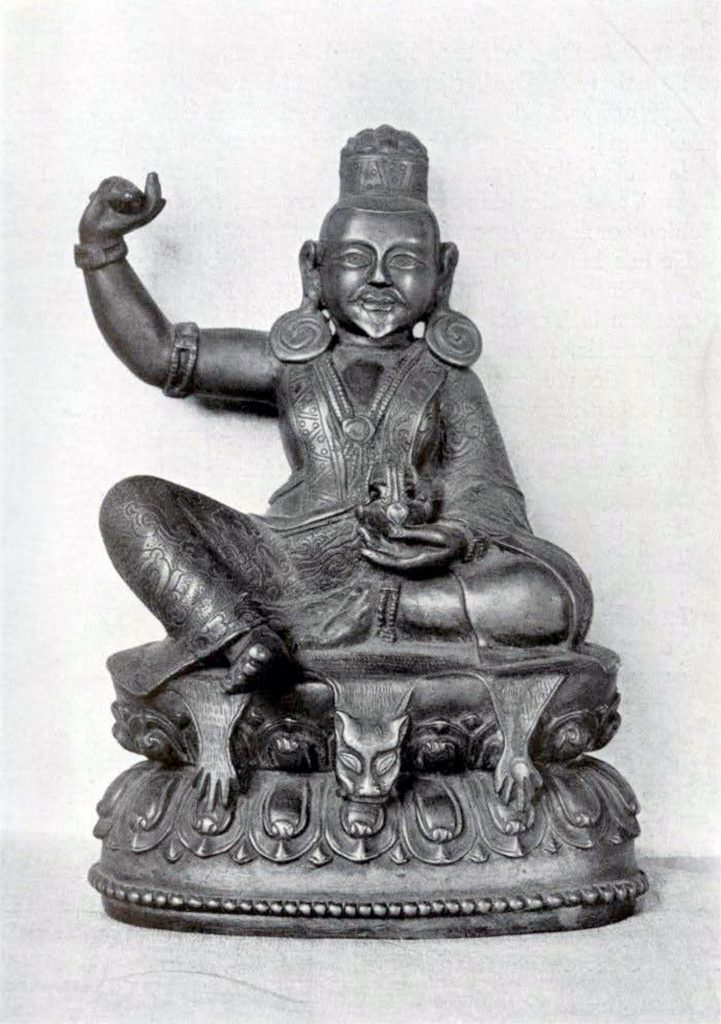
Museum Object Number: A1113
Image Number: 2169
He has his hair knotted at the crown of his head and wears conch earrings. This is the dress of a Sivaic Yogi, meaning that his doctrine is Yogic. But over all these, he wears a Buddhistic priest’s mantle, meaning that he is a Buddhist. He sits upon a throne of double petalled lotus, meaning that he has obtained celestial rebirth for himself and can also give it to others. His own name is Pal Dan Gönpe Jetchün Dorji Chhang Pal Tailo Gnyana-Bhadra, meaning the noble and all-powerful Tailo of the suspicious wisdom.
He is the founder of the Karjyüt Pa sect of Bhutan and Tibet and lived about twelve hundred or thirteen hundred years ago in India. (No. 1113.)
THE FIGURE OF THE FOUR-FACED, TEN-HANDED IMAGE WITH TARA OR THE FEMALE DEITY ON ITS LAP. THIS IS CALLED PALK-HORLODOMPA (Fig. 36).
Item 1.—The sexagonal throne, same as in the figure of Buddha.
Item 2.—The lotus throne and the sun and moon tiers, same as in the figure of Buddha.
Item 3.—The throne is supported by two elephants, meaning Bodhi Satwic Path or that this state of the conception of the Paramatma or Nirvana is founded on the Mahamic doctrines, which preach the path of the Paramitas. The Paramitas mean in Sanscrit transcendental wisdom.
Item 4.—There are the male and female in this. The male stands for wisdom and power; the female for love and mercy.
Item 5.—The male has eight hands (the noble eightfold path and the eight paramitas to be obtained thereby) each bearing a symbolical weapon or symbols of auspiciousness.
I will now begin with the upper of four right hands. It has a sword, which signifies wisdom to cut ignorance; next below that, the hand bears a hook like an elephant’s goad, meaning the hook of grace. The third below holds an arrow, meaning method and will. The fourth hand bears the Dorji in the front of the heart, meaning eternal peace and immortal life.
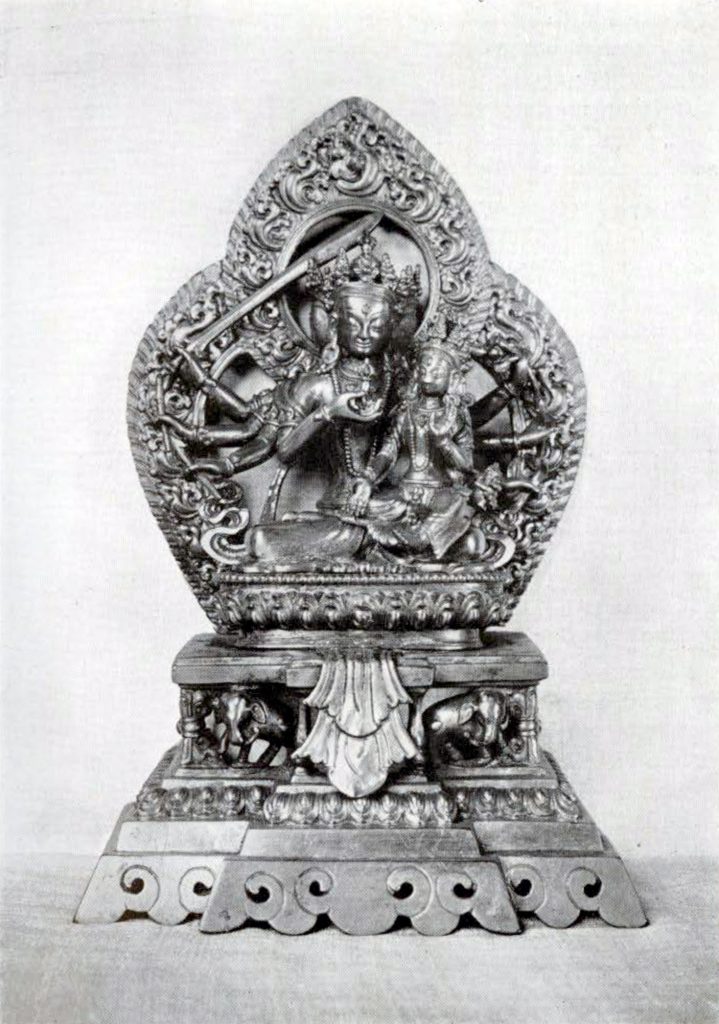
Museum Object Number: A1114
Image Number: 2170
The upper of the four left side hands bears a jewel sprouting from a lotus, meaning celestial rebirth and full attainment of one’s wishes. The second one below holds a lasso, which means affection. The third hand holds a bow meaning divine power. The fourth hand holds a bell signifying spiritual bliss and comprehension or omniscience.
Item 6.—The male figure sits in the Bajra Assan posture, meaning that his state is to be attained by Samadhi, or ecstatic spiritual bliss.
Item 7.—He has four faces, which means that he is always in the four incomprehensible and unbounded states of mind. They are:
First.—Boundless and incomprehensible compassion which says, ” Let all sentient beings be ever happy and let them always exist in happiness.”
Second.—Boundless and incomprehensible affection and sympathy saying, ” Let all sentient beings be separated from pain and the causes thereof.”
Third.—Boundless and incomprehensible love saying, “Let all sentient beings ever enjoy pure and holy happiness unalloyed with any pain and grief or tinge thereof.”
Fourth.—Boundless and incomprehensible equality saying, ” Let all sentient beings always exist in the state of equality and harmony, let them be always separated from ideas of partiality and likes and dislikes.”
Item 8.—He is adorned with all sorts of ornaments, signifying that he is the idea of perfection, for you may regard him from all sides, yet’ everything in him is perfect.
Item 9.—Tara is sitting on one of his knees, meaning that she is an emanation of himself.
Item 10.—Tara is the goddess of wisdom. She holds her right hand in the free gift posture (Chhokjin Chhakgya) which seems to say, ” Come and take,” and the left hand in the Kyapjin Chhakgya, meaning protection granting posture which says, ” Do not fear.”
Item 11.—Then last of all there is the floral halo around them both, thereby meaning that they who obtain this state of divine knowledge obtain also the power of enlightening others. The auroral, rainbow-like halo, is depicted upon metal in this floral style, else it should be a halo of rainbow. (No. 1114.)
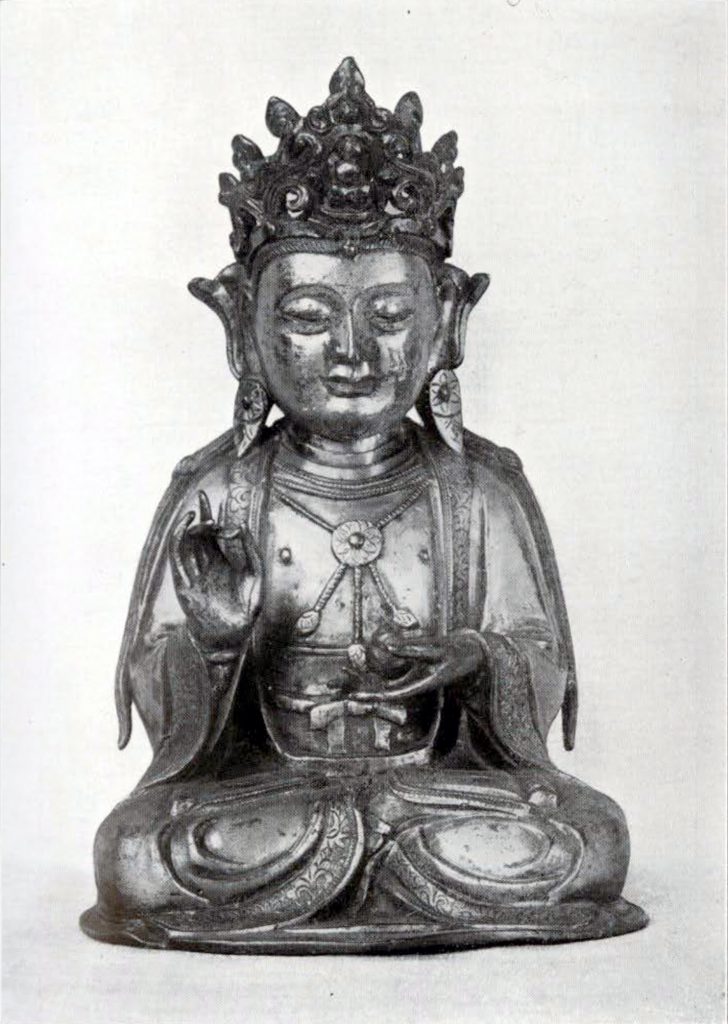
Museum Object Number: A1115
Image Number: 2171
BUDDHA KHORWAZEEK, THE ENLIGHTENED BEING WHO IS LOOKING DOWN ON THE SAMSARA WITH PITY (Fig. 37).—It must not be confounded with Buddha Gautama, for this is the figure of a Buddha who lived prior to Sakya Muni, by about three ages or Kalpas.
During the Buddha’s kingdom, the human beings of this world enjoyed the long life of ten thousand years each or more, and the world was not so full of sin as now.
This figure seems to have been separated from its pedestal. The thick coat of gold with which it is heavily overlaid and the fine make of high finish bespeak its being the property of a large monastery in Tibet or Nepal. The Nepalese inscription on the lotus throne is in Sanscrit, which I am unable to decipher. The lotus throne means rebirth and immortal life as in all similar and previous figures. The garb is the universal garb of Buddhas in all ages, consisting of the plaited and simple gown and wrapper of a Buddhist monk. The eruptions or cones on the head are supposed to be curls of hair, all curling to the right. The posture of the hand is called ” Thap-Shay, ” meaning ” method and intelligence” or “energy and wisdom.” (No. 1115.)
GURU PADMA-SAMBHAVA, the Lotus Born Teacher. This is a miniature statue or figure of the renowned and much worshipped Guru, who was the founder of the Tantric school of Buddhism in Tibet. His history goes that he was born out of a lotus in the midst of a lake somewhere in Kashmir or Urgyen.
The lake was called Danakosh Lake. The lotus birth means birth unsullied by a mother’s pangs or mother’s womb. And he is said to be the only incarnation of Buddha who is born out of a lotus flower, a birth which is only existing in the Dewa Lokas, or the paradise of the Dewas. His costume is the Regal costume of a prince of Tahor, ancient Cabul. His trident is significant of his having subdued the three poisons, lust, anger and sloth. His Dorje promises protection and obtainment of eternal life and almighty power, and the skull that he holds in the left hand is filled with Amrit of red color resembling blood signifying temporal blessings and inspirations.
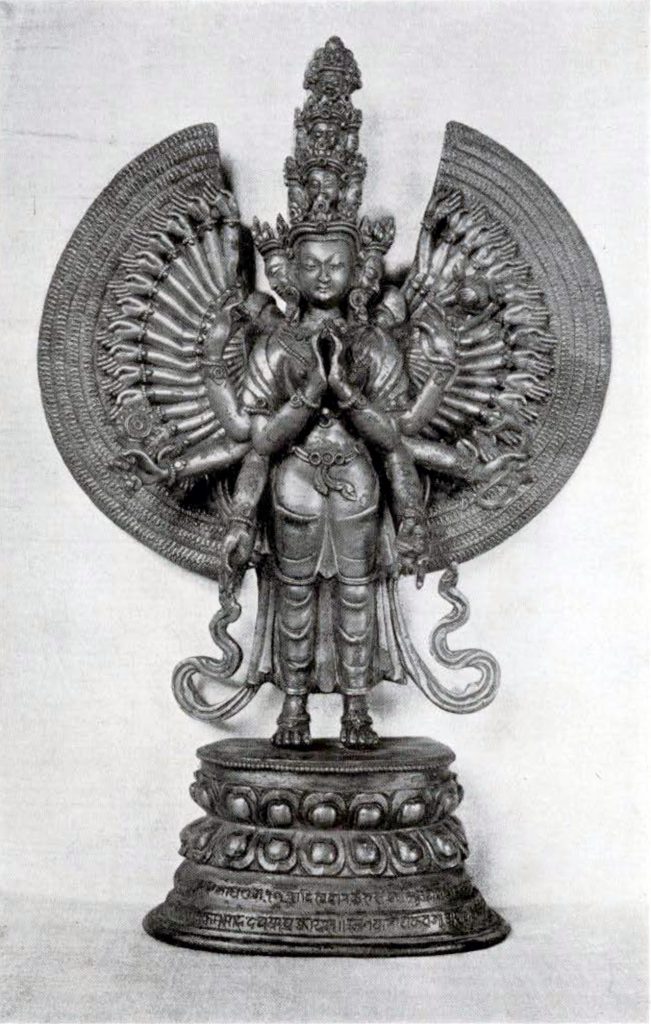
Museum Object Number: A1119
Image Number: 2174
His Mitre is also full of symbolisms, signifying a variety of attributes. I will not describe it minutely, but only say that it is surmounted by the feather of a vulture, meaning thereby that as the vulture is the highest and farthest flier among birds, his doctrine is the most aspiring and the noblest and highest spiritual knowledge. (No. 1118.)
ELEVEN-HEADED AVALOKITESHARA (Fig. 38); the God of Mercy, Chenrazee, the God of Compassion, who is ever looking down upon the beings in the Samsara with pity. The legend runs thus. Once upon a time many Kalpas (ages or eras) previous to the present one, Buddha Amitabha (of the boundless light and the source of life) emanated from himself a deity with the purpose of incarnating in the Samsara, to teach, guide and help all sentient beings existing in the Samsara (carnal world or sensual world) to liberate themselves from the web and network of Karma, the ocean of grief and misery, and to obtain Buddhahood (enlightenment).
This divine emanation was Chenrazee (the four-handed Avalokita of white color). Thereupon Chenrazee incarnated himself into innumerable Bodhisattvas and Arhats, who devoted themselves to preach the truth in all the six lokas (states of existence, that is Deva, Asura, Manna, Preta, Tiryaka and Naraka. Lokas) : gods, demigods, human, ghost, brute and hell regions.
In all these six lokas he multiplied himself innumerably and went on teaching, preaching, and showing the way to salvation. His mercy was boundless, his power almighty and his high and noble vow was that as long as there were any sentient beings grovelling in Samsaric ignorance and pain, he, the noble Lord of mercy, would not seek rest in the ecstatic tranquillity of Nirvana, but would remain active.
Thus the Lord had continued saving and redeeming the beings of the Samsara, and thrice emptied the six lokas of their inhabitants whom he had redeemed.
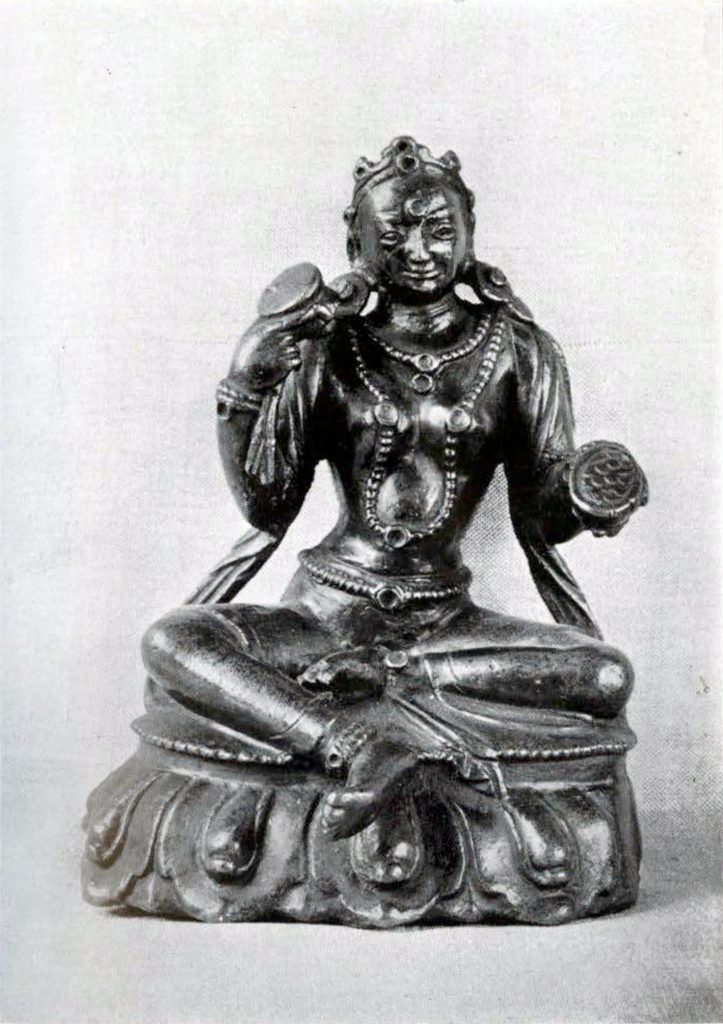
Museum Object Number: A1121
Image Number: 2173
Then the Lord was about to seek rest in Nirvana and ascended far above the highest sphere of the world of forms and from there he surveyed the illimitable worlds of the Samsara below which, by his mercy and wisdom, had been saved and enlightened and the Lord was regarding his work with satisfaction. But on longer observation the Lord beheld the beings existent in the cavity of the mountain Meru, which in numbers exceeded the saved ones so much that it seemed that the numbers of the saved to the unsaved was like a drop to an ocean, the drop representing the saved ones, while the unsaved ones were like the ocean in comparison. Thereupon the Lord, almighty and merciful as he was, despaired of being able to fulfill his vow of saving all, and wished to seek rest in Nirvana. But the divine vow was not broken nor set aside lightly; his divine head burst into nine parts like the lotus and the Lord fainted with pain, anguish and sorrow for the suffering of the beings whom he had vowed to save and was about to leave unredeemed. This divine repentance was accepted by Buddha Amitabha and the concourse of Buddhas, who thereupon bound up the nine broken parts, transforming each part into a whole head, and endowing each head with a divine power. Upon these nine they conferred the gift of two more heads, that is, the black head of Siva (lord of destruction) and above all the head of Amitabha of the red color (source of life eternal). They armed him with one thousand arms, supported on eight main arms bearing the following symbols: the two uppermost folded in the attitude of prayer at the breast, the second right arm bearing the beads (symbol of saving), the fourth right arm bearing the Chakra (wheel of sovereignty), the second left hand bearing lotus (symbol of celestial rebirth), the third hand bears the urn of relics (symbol of eternal fame and renown), and the fourth hand, bearing bow and arrow (symbol of wisdom and power, intelligence and energy). Then the remaining nine hundred and ninety-two arms or hands are each decked with an eye in the palm thereby making one thousand hands in all with one thousand eyes. The hands are meant to represent one thousand Chakravarti emperors, each of whom will rule over the whole world for a time, by virtue of the power given by the Dhurma, and the one thousand eyes are symbols of the one thousand Buddhas who will come during this Maha Kalpa or other period of the existence of the present system of the universe.’ (No. 1119.)
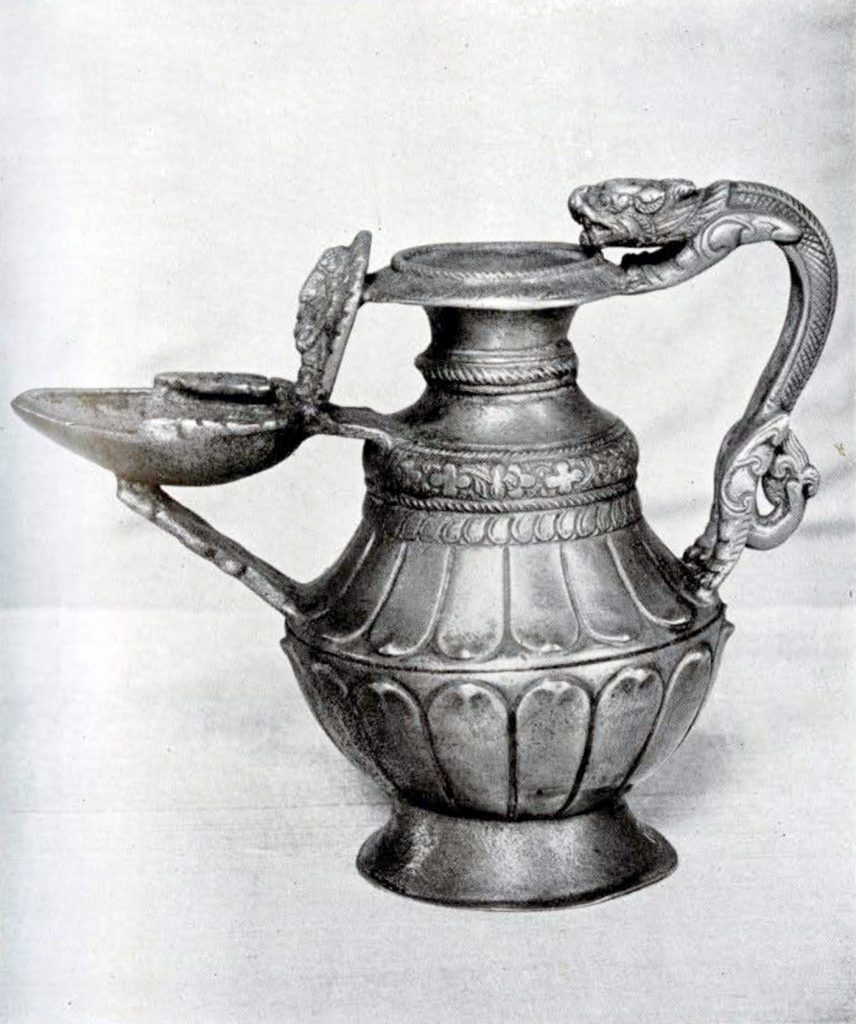
Museum Object Number: A1124
Image Number: 2197
FIGURE OF MACHIK LAP-KYI DÖNMA (Fig. 39) (abbreviated name, Machik Lapdön).—A saint of Chötyul Sect of Nyingmapas. She is deified, and worshipped as an incarnation of Dorji Phagmo or Dorji Naljorma (the diamond sow) Lady.
It is said of her (Lapdönma) that ” There are millions of books translated from Sanscrit into Tibetan, and adopted by the Tibetan Buddhists, but it is only Machik Lapdön who has succeeded in preaching an original Tibetan Buddhistic doctrine, which has been appreciated and adopted by the Indians themselves, rich as they are in Shastras, Vedas, and Puvans.” Her doctrine is that the clinging to life and self should be destroyed by practising at first an imaginary gift of one’s own body, the flesh, blood, brains, entrails and lastly, of one’s merits and demerits, and everything that one clings to, to one’s most hateful enemies, such as the enemies (visible and invisible) who may wish to shorten one’s life, covet one’s fortunes and luck and those who may long for one’s meat and blood.
She holds in her right hand, the Damaru or Chötdam (timbrels) which she sounds in accompaniment to her incantations and prayers. She holds in the left hand the skull filled with offerings, which she offers as gifts to the deities and demons (which her imagination conjures up). She is adorned with bone beads and a simple headdress.
Regarding the figure itself, it seems to be at least six or seven hundred years old and must have been made by a devotee in her doctrine, as is visible by the patched up rent in the throne of lotus. She was the founder of a sect called the Chötyul Gyütpas, who are always seen with a thigh bone trumpet, a skull bowl, a timbrel and a bell, and sometimes a trident. This figure is made of copper, which came out in pure state and did not require to be smelted in fire, and hence is held as sacred amongst Tibetans. It is held to be dearer than silver. (No. 1121.)
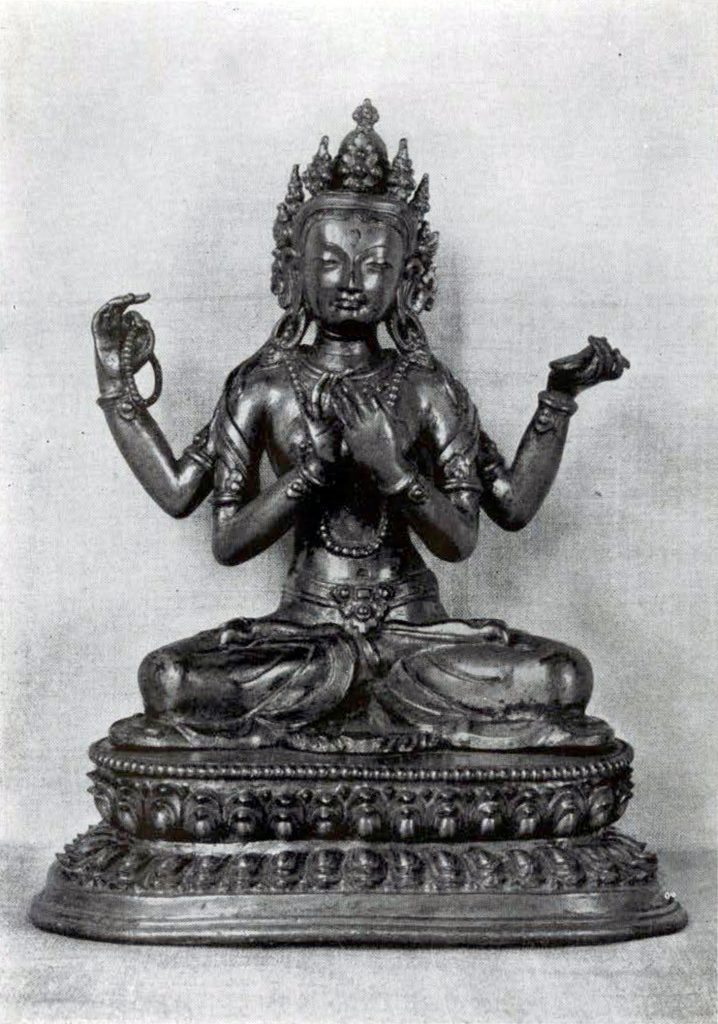
Museum Object Number: A1125
Image Number: 2176
FIGURE OF GYALWA LOPZANG TAKPA and his tutelar guardian angels, disciples and saints whom he equals in knowledge. He is believed to be the incarnation of Manjusri, as is seen by the emblems that he bears, that is, the sword of wisdom on the right, and the sacred volume upon a lotus flower of truth and resurrection or rebirth and surmounted by the Mani (gem) emblem of the threefold refuge.
He holds his hands in the mystic posture of Thale and Shay, meaning method and knowledge, signifying thereby that he is possessed of both in the spiritual sense.
He combines the discipline of Buddha with the mystic and sacred symbolism of Esoteric Tantricism preached by Guru Padma. Sambhava.
There is Buddha on his crown, with two of his most eminent disciples, Shariputra and Mondgalyawa Putra on his right and left. This signifies that this saint Gyalwa Lopzang Takpa, the founder of the Getukpa creed, the present established church of Tibet, is a true descendant of Buddha in whose time he had live. in the shape of Ananda, the most beloved of all of Buddha’s Sramana disciples.
Gyalwa Lopzang Takpa is surrounded by four of the most renowned saints of his line and doctrine who succeeded him.
Below him are his three tutelar deities who guard his faith and hierarchy. They are Tamcheu-Chhoygyal (Yama Raja) or king of truth, that with the buffalo face to the left. Then there is Thamchen Dorji-Jigjit, the small pair in the front below the saint’s lotus throne (these are the deities who superintend Yama Rajah). There is a third figure (which I am not familiar with) called Sannzi-Zuchan Pao (incarnation of Gonpo Zyal Zhyi). There is a figure of Jetchun Mila Ropa to the left and Dupthop or Siddhi Purush called Dögon Liugji Repa.
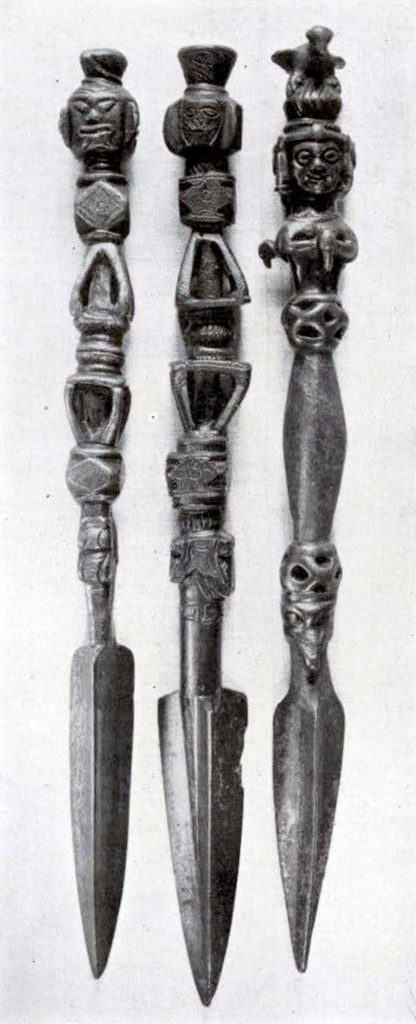
Museum Object Numbers: A1149 / A1152 / A1126
Image Number: 2184
The four disciples are Khedupje, to the left—Gyaltchhapze, second figure to the right—Jamyang Chhoji (head of Depmy monastery), second figure to the left—Khedup Gyatchho (head of Sera monastery).
This group is for the use of a beginner in meditation to make him familiar with the names of the previous saints and tutelar deities of his line. (No. 1122.)
NEPALESE LAMP (Fig. 40).—This is the lamp used in Nepal by all men of position, and especially on altars. The post or run is the oil reservoir and the dish is the lamp itself.
The figure on the lamp is the image of Vishnu and the two smaller ones are Ganeshes. The nine serpents are the nine heads of the Shesa Naga, mentioned in the Maha Bharata who is supposed to be the supporter of the earth (Sec. XXXVI Astika Parva Maha Bharata).
The four-handed figure is Narayana with Garuda under him. The spoon is used to pour out the oil from the urn into the lamp. (No. 1124.)
DHARMA KAYA-MAHA MATRI (Fig. 41), ” The Original Word,” “The Great Mother,” Prajna Paramita or Maha Matri, The Mother of All the Foregone Attainers of Nirvanas, called Jinas, conquerors or victors.
1. The triple tyres and the double petalled lotus thrones here mean subjugation of three vices (anger, lust and sloth) and triumph of the saving virtues of love, purity, untiring perseverance and watchfulness. The double throne of lotus petals signifies that those who contemplate this symbol and act according to her divine enlightenment and omniscience are able to show the path and give the power to do so to others also.
2. Here the lotus is only half way around the throne. That there are no petals on the back part of the image is not an omission, but has a significance of its own. It means that she, the doctrine mother of all truths, is attainable only by those who seek her intently and from the depth of their hearts and not by those who do not seek her.
3. She is adorned with the thirteen items of a perfectly dressed lady, the headdress, the earrings, the arm and bracelets, the necklace and garland, the jewel on the waistband, adornment for the feet, the silken folds behind the ears attached to the crown, the upper garment of silk of various colors, the waistband, three separate pieces of clothing below the waist, and the ring on the ankles, in all thirteen, which symbolize the thirteen degrees of perfection which complete Nirvana.
4. In the right hand she bears the beads, which signify “I take you all up one by one.” In the left hand she holds the Dharma Volume. “I am the truth, and I hold the law.” The two extra hands are in the attitude signifying the turning of the Dharma Chakra, or setting the wheel of truth in motion. The forefingers and the thumbs in both hands touch each other; making a ring, and the tips of the fingers touch each other, meaning the conjunction of truth and wisdom in the right hand, justice and mercy in the left, and the conjunction of these four typifies the act of turning the “Wheel of Truth” setting the “Dharma Chakra” in motion (in other words preaching the true gospel).
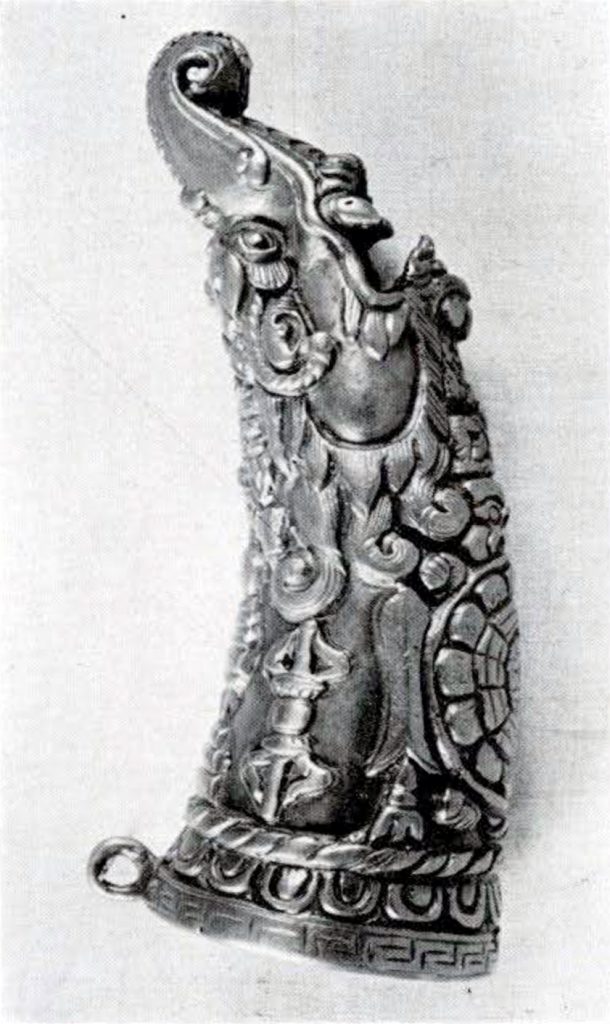
Museum Object Number: A1127
Image Number: 2180
5. The four hands here signify compassion, affection, love and impartiality or equality of regard for all sentient beings.
6. The mitre has four tiers surmounted by a Dorji (or the symbol of eternal life or eternity itself) and this means that the boon she can grant or confer is above anything which is to be found in the four states of existence, (1) which the human or Titan world can give, (2) Indra’s or the sensual paradise can afford, (3) Brahma’s heaven can give, (4) above everything that the spiritual or formless heavens can grant. It means the obtaining of eternal life and merging into the. Omnipresent.
7. The five crowns or jewel peaks typify the five perfect attributes of the divine perfection expressed in Tibetan short style as Gwalwa Reenga, literally the five kinds of Jinas or victorious ones. One attribute is symbolized by one Buddha or Jina. And the five Buddhas are
(2) Ratna Sambhava (The Precious Product).
(3) Amitabha (The Boundless Light or the Source of Life).
(4) Amogha Sidhi (That which fulfills all that has to be done).
(5) Vairochana (The Creator of Forms). (No. 1125.)
THE OLD IRON PHURPA WITH BRASS MOUNTINGS (Fig. 42 c); Devil Killing Dagger.—The three edges of the dagger mean the three virtues. The dragon’s head is what we call a Chhusen, meaning a sea lion or some antediluvian creature like the leviathan, which was most terrible to look at and was therefore adopted as the symbol of divine and righteous wrath that would exterminate sin. Psychologically, it would be the will, which is a terrible power and carries everything through whether it be guided by good or bad motives. The simple pillar here represents Mount Meru, which is supposed to be of this shape, tapering towards both ends. It is surmounted by the same symbols, only more elaborately done for the sole purpose of religion, and is not for sale. The three heads also are Bajrapani, Hayagriba and Amrita Kundali. The bird on the top is supposed to be Garuda, the personification of aspiration and righteous ambition. This Phurpa is from five hundred to six hundred years old. (No. 1126.)
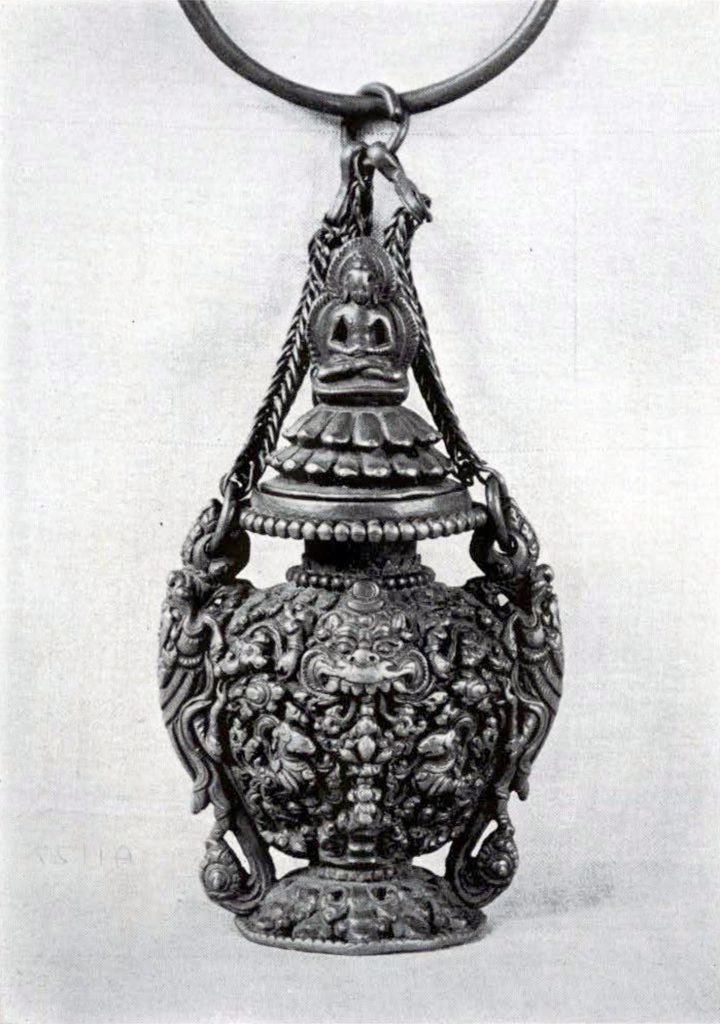
Image Number: 2181
THE BRASS MAGICIAN’S MESMERIC HORN OR EXORCISING HORN (Fig. 43) called Thün-Ro or Magic Horn have given the explanation of another article of the same kind; I remember it was of horn, but as this is more elaborately decorated and has all the required signs and symbols upon it I will go over this minutely.
1. The dragon’s head (leviathan’s or literally speaking, sea
lion’s head) is a symbol of divine wrath. The terrible feature of the eternal being which consumes all iniquitous actions and doers thereof by the flames of his righteous wrath, and hence the mesmerized mustard seeds, each supposed to appear to the unclean spirits as a deity, can only be propelled forth from the mouth of a leviathan.
2. The magic power and force of the mesmerized seeds are supposed to be so strong and powerful that nothing but an emblem of the Dharma Kaya, “the word” or “truth” alone can hold it down, and hence the Chörten on the top.
3. It is so wayward, that only the seven planets can balance it, herein symbolized by the astrological signs of the seven planetary spirits presiding on the seven days.1
Monday—the crescent.
Tuesday—a red eye.
Wednesday—a hand.
Thursday—a phurpa.
Friday—a knot.
Ketu—or Rahu—or Saturday—a bird of ill omen.
4. Then there are the symbols of all the deities invoked in the ceremony.2
The Diguk or crooked hacking knife for Phaktno, the diamond sow lady.
The Dorji for Bajrapani.
Manjusri’s sword.
There are two or three signs more wanting in this, which, if added, would make it perfect. They are a row of Dorjis along the rim and a Dorji Gyadam on the base (crossed Dorji). (No. 1127.)
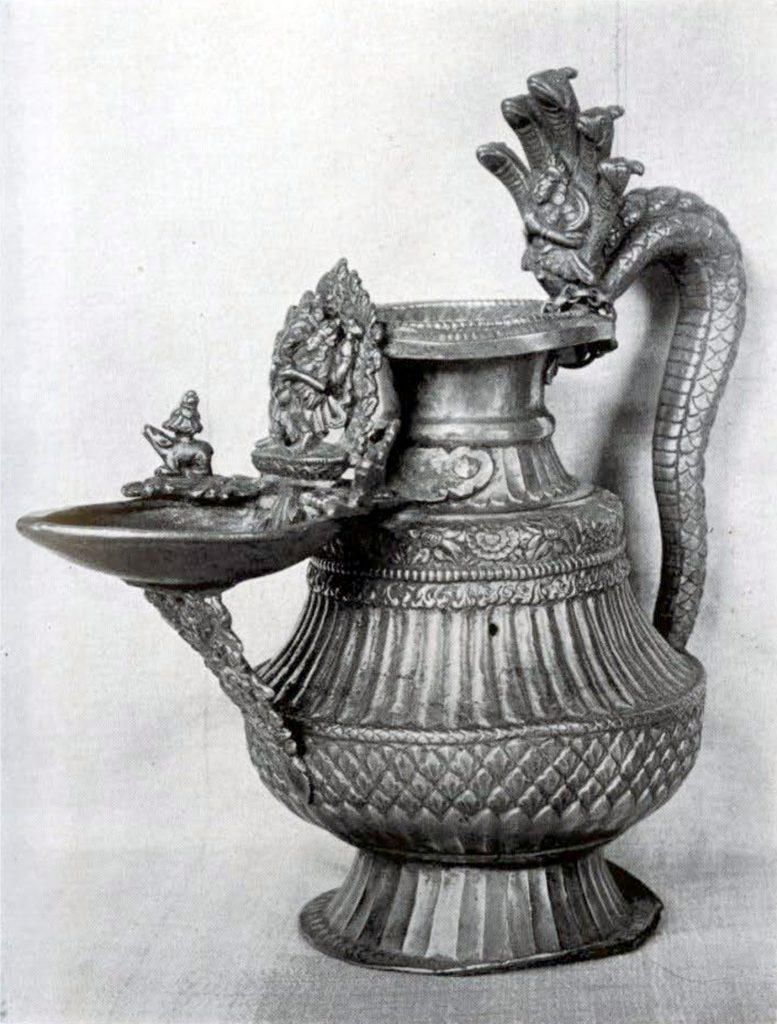
Image Number: 2196
THE MAGICIAN’S HORN.—This horn is used to contain the mesmerized mustard seeds used by the lama sorcerers, in exorcising demons. The mesmerized mustard seeds are supposed to strike the evil spirits with the force of thunderbolts, and appear to them like the fierce tutelar deities invoked by the sorcerers.
The mustard seeds are supposed to be such terrible spiritual missiles that they cannot be kept down unless a Chörten is carried on the upper portion of the horn, the Chörten being the emblem of truth. Nor can this Mthün (missile) be supported, except by the tortoise emblems (Patience). Nor is it issued from any other but of the leviathan’s mouth (Chasing, sea lion). Such is the
brief explanation of the horn, which is a constant companion and appendage of the tantric Buddhist lamas. (No. 1271.)
THE PHURPA OR MAGIC DAGGER.—The Dorji on the top is significant of immortal life, invincible power and irresistible force. The three faces of divine wrath are the three times deified, in which the supreme being exists eternally and the law in their active phase.
The widely opened mouth of one suggests that the divine wrath is consuming vice and vicious beings now.
The half open mouth means that it has done so in the past.
The closed mouth, with the nether lips bit by the upper one, and showing the teeth with a menacing aspect is expressive of future wrath, or contemplation of future punishment.
The knot of immutability is expressive of the fact that the law is immutable through all time, space and eternity. The pillar of lotus ending in the lower knot is a symbol of stability, symbolized by Mount Meru which it is supposed to represent. The head of the water dragon, lion or leviathan is the combination of all the terrible features of the divine and eternal being, embodied in one imaginary form of terrific wrath, the vastness and magnitude of which cannot be comprehended by any finite being, but which can only strike him dumb with terror and awe.
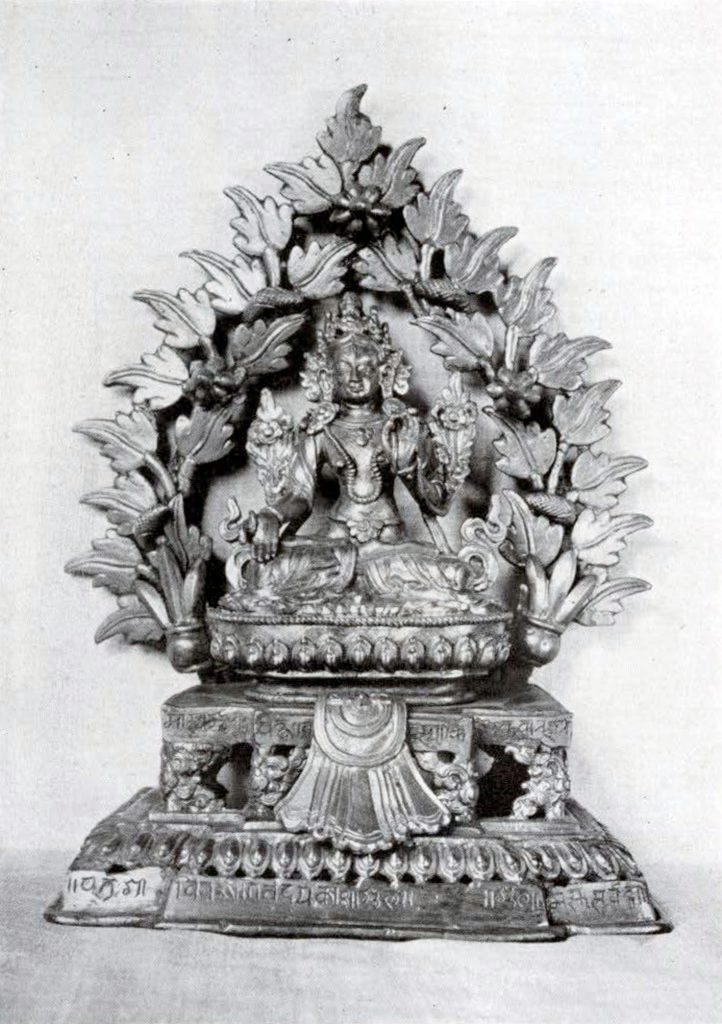
Museum Object Number: A1112
Image Number: 2168
The dragon’s mouth not only projects for the sharp pointed, three edged dagger (phurpa) but it is supposed to emit flashes of fire, flame, smoke, and thunderstorm. The capacious throat gives vent to a roar which equals the roar of a thousand claps of thunder and the rumbling noise after it.
The dragon’s nostrils send forth a volume of smoke and piercing wind or cyclone which envelops the three regions, with a pall thicker than night; the cyclone whisks the unhappy evil-doer from any part of the boundless universe and drifts him in the dreadful presence of the terrible judge. The sight of the terrible being, the roar of the spacious throats, strike him motionless and dumb. He is powerless to move, yet conscious of his impending fate.
The terrible Phurpa is descending.
His Atma flies out of itself; it is attracted by the keen edge of the weapon.
Below this is a secret.
Even thus far is scarcely permissible. but as I read of similar ceremonies and rituals of the ancient druids, I think it no harm to publish them. Such is an extract from the explanation of a phurpa of this type, which is called Pal-Dorji-Zyönu, the noble eternal youth. There are others of different types. (No. 1128.)
THE EUCHARIST’S INKSTAND (Fig. 44).—This inkstand is used in a certain ceremony called Wang koor or Baptismal, where it is represented as being the mother of the truth, inasmuch as it is from it that the ink is supplied with which Holy Scriptures containing divine truths are written.
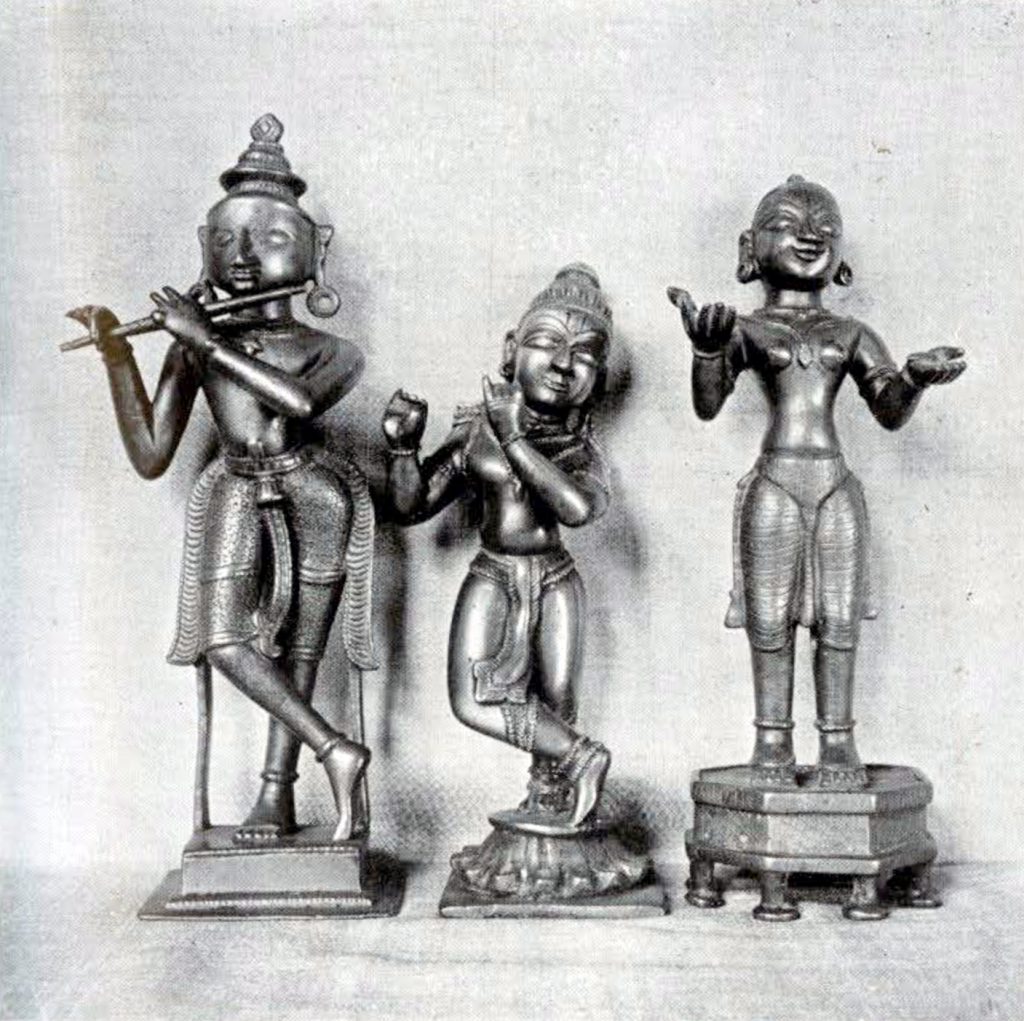
(b)The Eighth Avatar of Vishna as Krishna.
(c) Brass Casting of Johdpore Rajpatana.
Image Number: 2317
It is surmounted on the top by the image of Amitabha (Buddha), the Dharma Kaya, or the source of illitimable light. He is enthroned upon the usual throne of upturned lotuses and a double throne of inverted lotuses. This means that as he is the source from which all life and light springs, he is above all, perfect, which state suggests forms and qualities. But Amitabha exists in the state of the formless, past all qualities or adjectives. The pattern wrought upon the inkstand itself is meant only to beautify it and does not mean anything more than some symbols of auspiciousness and luck.
The two handles are sea lions or leviathan. The middle figure is a Chimiuda or something which does not resemble anything and the two other devices are meant to be sea horses. (No. 1129.)
THE SAUDAL PHURPA. Some of the same type have been explained before, so this only differs from many others in its being surmounted by the hairs tied up in a knot on the triple head of the deity, Palcheu Dorji-Zyönu, the great and noble, eternal youth.
Although to those who are not acquainted with the inner mysteries, it may appear that this slight difference does not mean anything beyond a little matter of taste or so on, yet to the Buddhist lamas themselves, the slight differences mean much, as the Phurpa surmounted by a horse head (as is often seen) is not and cannot be used where this one would be, nor vita versa. In the lower portions the explanation is the same as in the others, so I need not reiterate them. (No. 1130.)
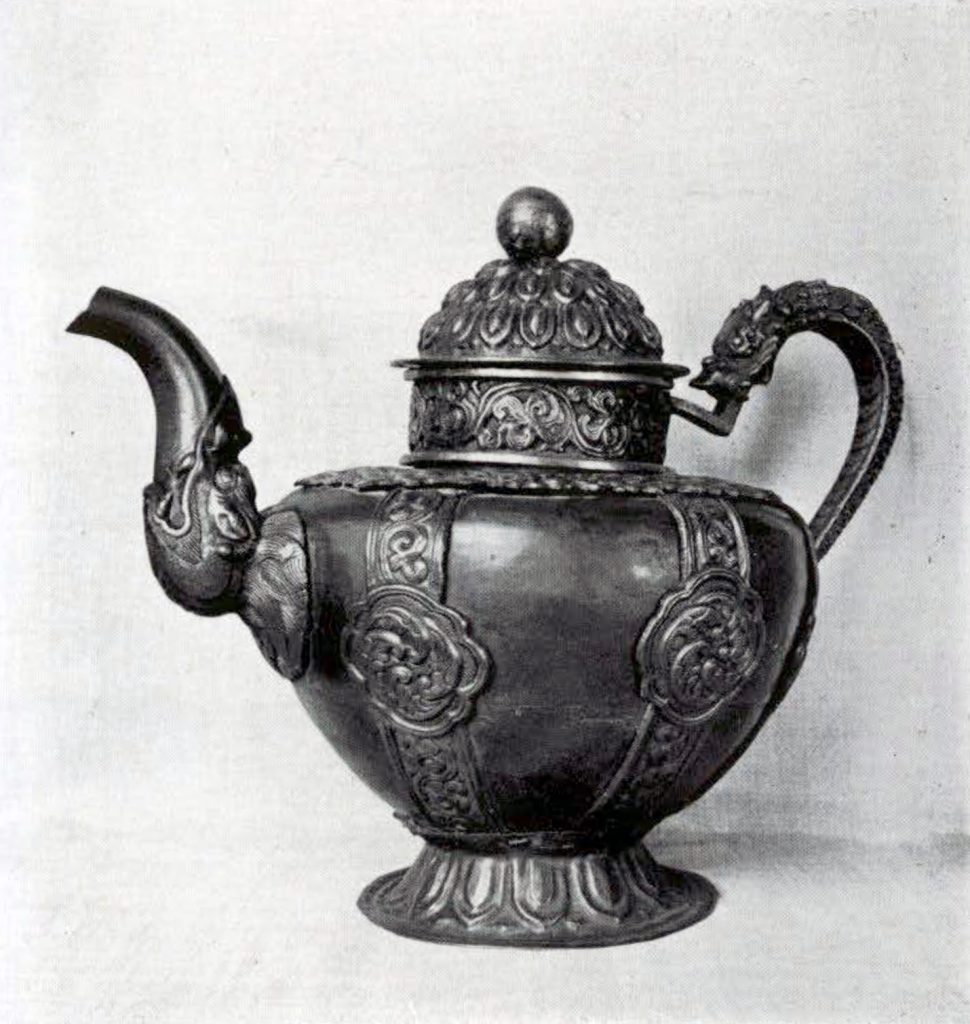
Image Number: 2201
PAGODA WITH POUR BUDDHAS.
1. The base consists of three tiers, meaning the three material worlds, that is, the Human, the Titans and the Pretas, which are the lowest.
2. The perpendicular base hung with garlands of beads or rather, network of garlands, the celestial regions of the long-lived Devas.
3. Five more tiers of smaller sizes, meaning the sensual paradises of Devachan or Deva Lokas.
4. The lotus throne, as explained before, meaning in this case the heaven of Tushita where Buddha Maitreya of the future is at present dwelling in the shape of a Bodhisattva and ruler of that heaven.
5. The double throne of sun above and moon below, means that thenceforth a jinn who has attained thus far, is able to enlighten others and has gained omniscience himself.
6. The throne supported by eight lions, signifying the eight Paramitas, six described in my sixth explanation of Tara, and two more being, seventh—boundless power of prayers or wishes (Man Lam) the path of wishes; eighth, boundless method (Tib Thabkyi Pharoltu Chhiupa).
7. The four Buddhas who have come to preach the noble four-fold truth (the four-sided pillar) to the world out of the list of one thousand and two who are to come during this Mahakalpa, or Great Period: (1) Shakya Thubpa, (2) Wöt Sung (Sangay), (3) Sangay Murmedzat, (4) Khorwajik.
8. The lotus flower above them means that their doctrine leads to rebirth in the sacred and holy Nirvanic regions.
9. The snake above in a ring means eternity, signifying thereby that rebirth in Nirvana means immortal rebirth indeed.

Museum Object Number: A1168
Image Number: 2199
10. The dome above that means that the word or Dharma Kaya is above all emanations, or in other words, “the word is above all,” and that it is adorned with thirty-two signs of perfection wherever it incarnates.
11. The four-sided pillar adorned with light eyes means that the supreme cause of all causes, the Dharma Kaya, regards the all-existent sentient beings with compassion, affection, love and impartiality in all the directions of the compass.
12. Thence upward there are thirteen grades or rings, each ring implying the attainment of one perfection up to the thirteenth which is considered to be the highest state of perfection. (No. 1132.)
IRON PHURPA, OR DEVIL KILLING DAGGER.—The triangular blade or point signifies charity, chastity and persevering patience which are the three virtues capable of destroying the three vices, hatred, sloth and lust. The dragon’s head signifies the terrible feature of the righteous wrath, with which we ought to confront the three carnal sins.
The knot above the head is the knot of immutability, preserving the same nature tinder all circumstances.
The Dorji above that is the symbol of the immortal indestructible nature of our souls or Akma, which emanate originally from the cause of all causes, that is, the eternal being.
The three heads on the top signify that when the three vices are destroyed by the three virtues, the Atma develops into the three-fold divinity. This Phurpa seems to he about one hundred and fifty years old. (No. 1152.)
FIGURE OF KÜNKHYEN PAYKAR; whose real name is Künkhyen Ngawang Norhu, meaning the foremost omniscient jewel of the power of speech. He is the foremost incarnation of the present Dharma Rajah of Bhutan, and is now supposed to have been reborn about fourteen times since he first came as Künkhyen.
He wears the usual Nyingma lama’s dress, and has the peaked long hat of that sect, but which is flat on his head.
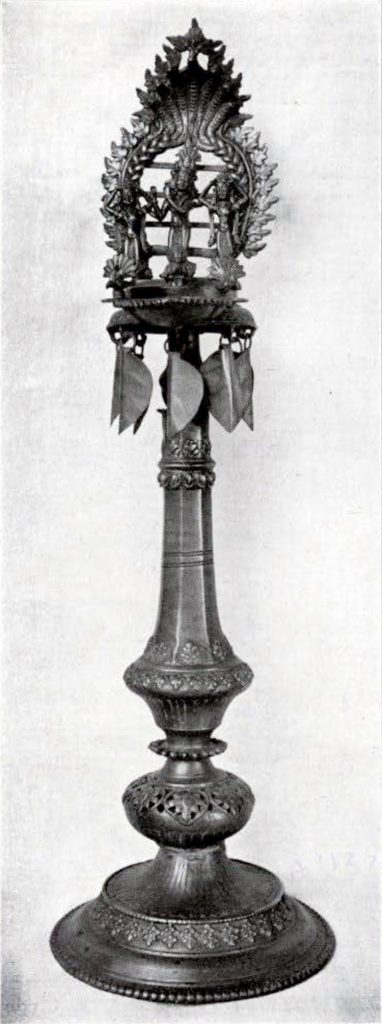
Museum Object Number: A1169
Museum Object Number: 2198
His right hand is in the posture signifying the turning of the Dharma Chakra, and his left hand bears an emblematical urn of life, called a Tchebun, an emblem which the lamas put upon the head of their laymen or disciples. He wears the plaited dress of a Buddhist priest, and the usual Lötchi or Töngak and Shamthap, the vest and gown of a lama. This is supposed to he a likeness and must have been made for the benefit of his future incarnation and his then existing disciples. This figure must be about two hundred and fifty or three hundred years old. (No. 1163.)
GREEN TARA.—The figure of Dölma or Tara incarnation of Avalokita, or the god to whom the prayer Om mann Padmehium is recited.
She is the goddess of wisdom, mercy, providence, saviour, guide (and bounty giver).
She is represented in twenty-one different kinds, postures and colors, some of which have been explained exoterically by Waddell in his “Lamaism,” in verses, the meanings of which are quite credible.
It is said that by worshipping Tara, the personification of motherly affection, divine wisdom and sin-forgiving power, one obtains both protection from evils and accidents, one’s wishes are fulfilled, obtaining sons, wealth, prosperity, long life, health, and power in this world and spiritual development and growth in the next.
She is a symbolical figure.
She is represented as being a lady in her sixteenth year (budding of virginity) to show that she is the personification of all the attractive and lovable attributes of the cause of all causes combined in one form.
She sits in the Padma Asan posture resorted to by Bodhisattvas, meaning thereby that she is to attain by self-sacrifice (self-denying resignation) the path of the Bodhisattvas and Samadhi combined together.
She holds her right hand in the Chhokjin or Gaining Posture, meaning thereby that she is calling every one to the feast of plenty that she can yield without any partiality, saying, “Come and take.” She holds her left hand in the Kinchoksoomtchhor posture (threefold refuge symbol), meaning thereby that she is the combination of the threefold refuge (Buddha, Dharma and Saugha). She holds the stem of the lotus of celestial and immortal birth typified by the lotus. She also sits upon the double throne of lotus, meaning thereby that for herself she is immaculate and exists in the immortal regions, and also that for others she takes various forms to fulfill the wishes of all other Jinas and Buddhas; she descends into the Samsara under various guises, in all forms, but always as a transcendental and somewhat supernaturally beautiful being, thus serving to attract those around her to something higher and nobler; inspiring them with love, admiration, confidence, faith and other noble, virtuous sentiments which human nature is capable of.
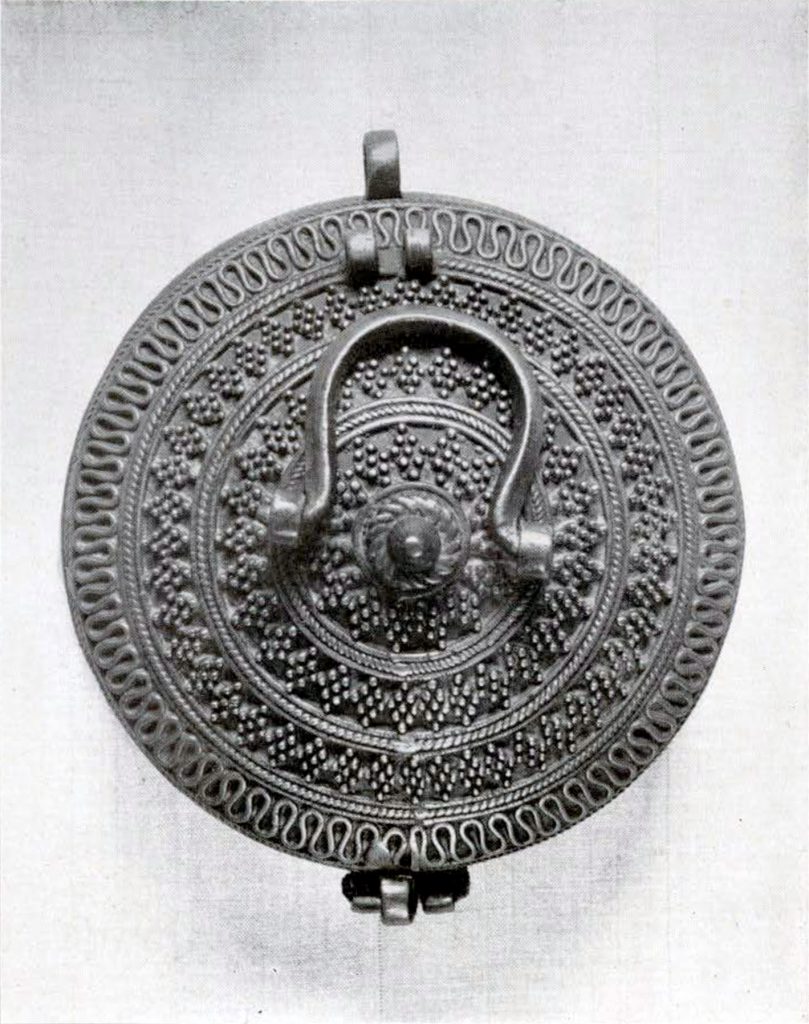
Museum Object Number: A1180
Image Number: 2320
Her one foot (the right one) is extended and supported by a smaller lotus flower, meaning thereby that, in so incarnating herself and coming upon her mission of love, into this Samsara, she has a dual existence, one existing in the eternal heavens among the immortal Jinas in the purely spiritual state of ecstatic bliss of Nirvana, and the other in the worldly form possessing all the divine powers and intelligence in a microscopic form, capable of developing into the all-pervading knowledge of wisdom and power herself and also of imparting that power to others. She also has the floral halo around her (which should be of rainbow-like color) which symbolizes fivefold perfection, because the simple primitive colors are five: white, blue, yellow, red, and black, each standing for one attribute and perfection.
She is adorned with the six ornaments: headdress, earrings, necklace, bracelets and armlets and feet adornments, typifying that she has obtained perfection in the six Paramitas, that is, Dana Paramita (boundless charity), (2) Sila Paramita (boundless discipline and purity), (3) Khsauti Paramita (boundless perseverance), (4) Birya Paramita (boundless patience), (5) Dhyana Paramita (boundless tranquillity), (6) Prajna Paramita. (boundless spiritual wisdom) . (No. 1171.)
ALTAR VESSEL FOR HOLDING MANDALA RICE.—The rice is offered and thrown towards the altars in the name of the Trinity (Buddhist), and it is only a great and devout Avatar Lanca, or head of a monastery, who is allowed to use the vessel for this ceremony. The cover of the vessel is surmounted by the pineapple, the symbol of plenty. The sides are decorated with figures of the dragon, the symbol of power and influence, and the bat, the symbol of luck. It is a modern pattern after Tibetan religious objects had been influenced by Chinese signs and symbols. (No. 1172.)
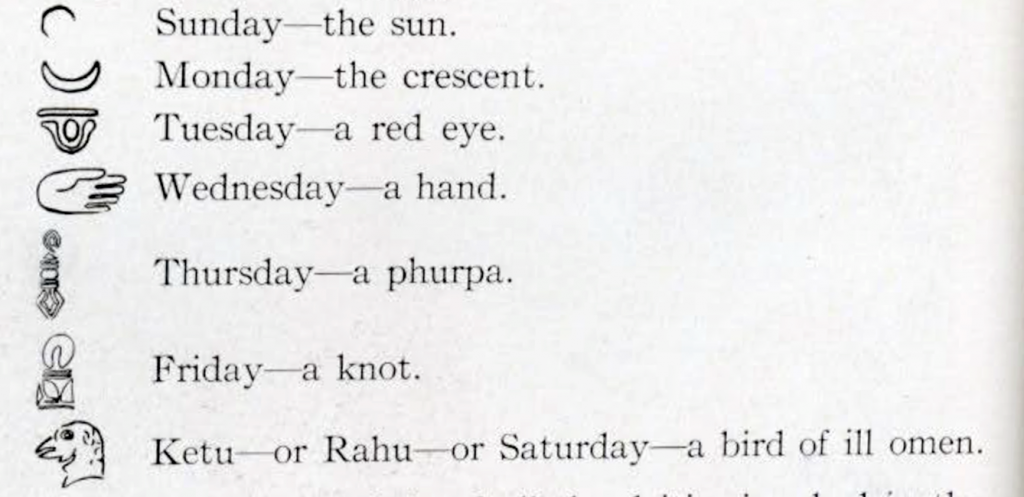
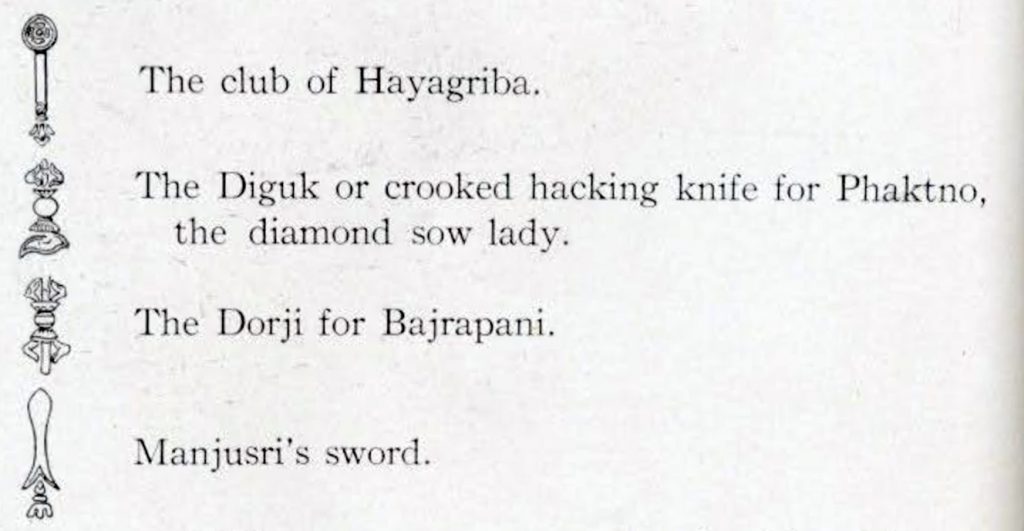
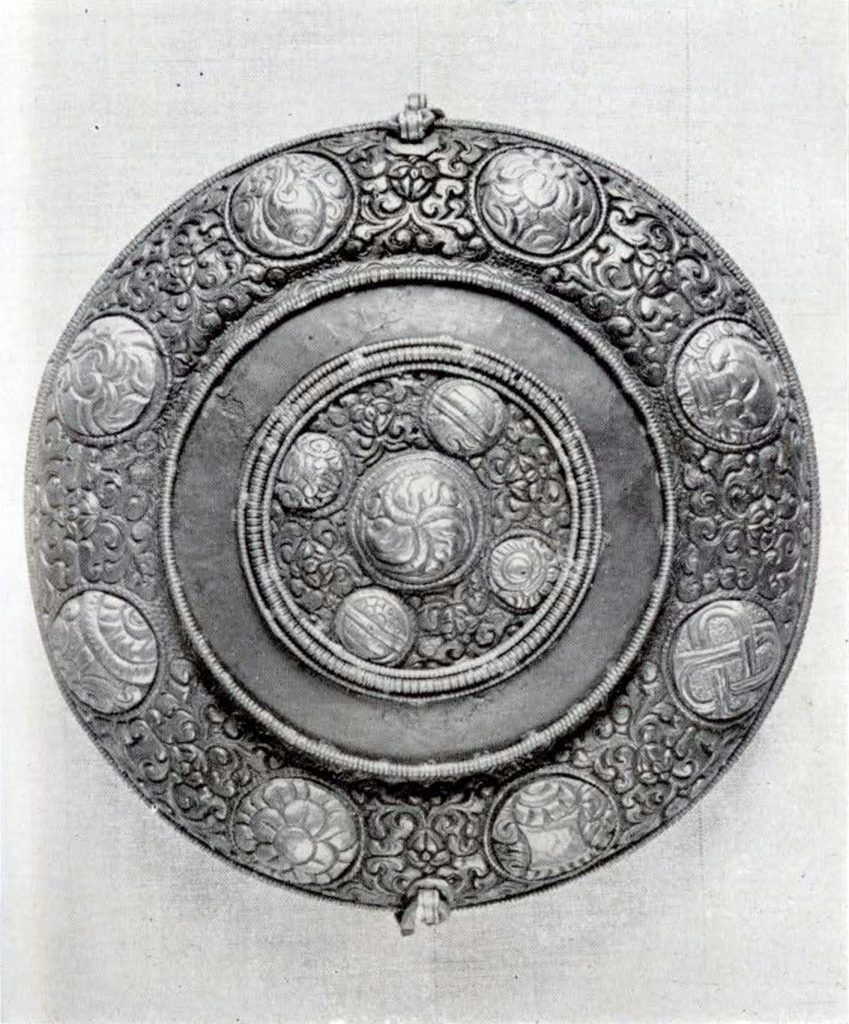
Museum Object Number: Probably A1240
Image Number: 2195
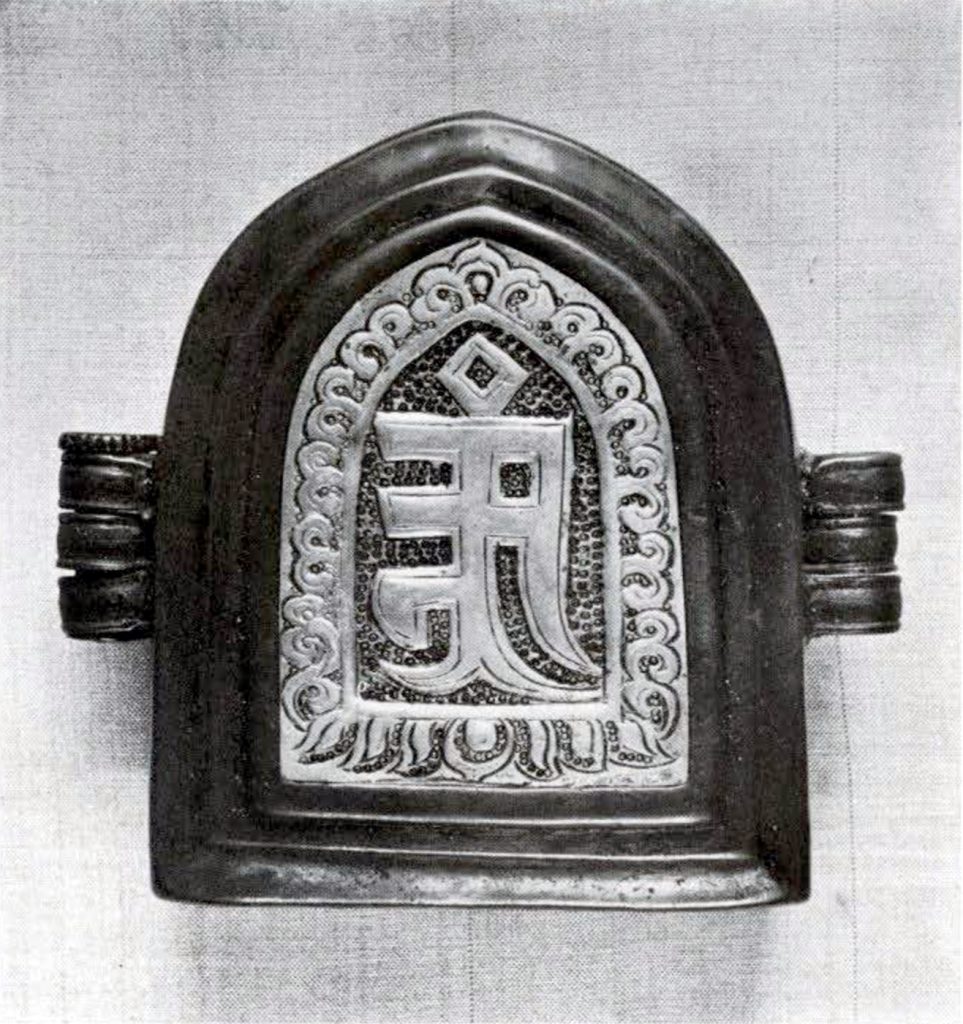
Museum Object Number: A1244
Image Number: 2183

Image Number: 2189
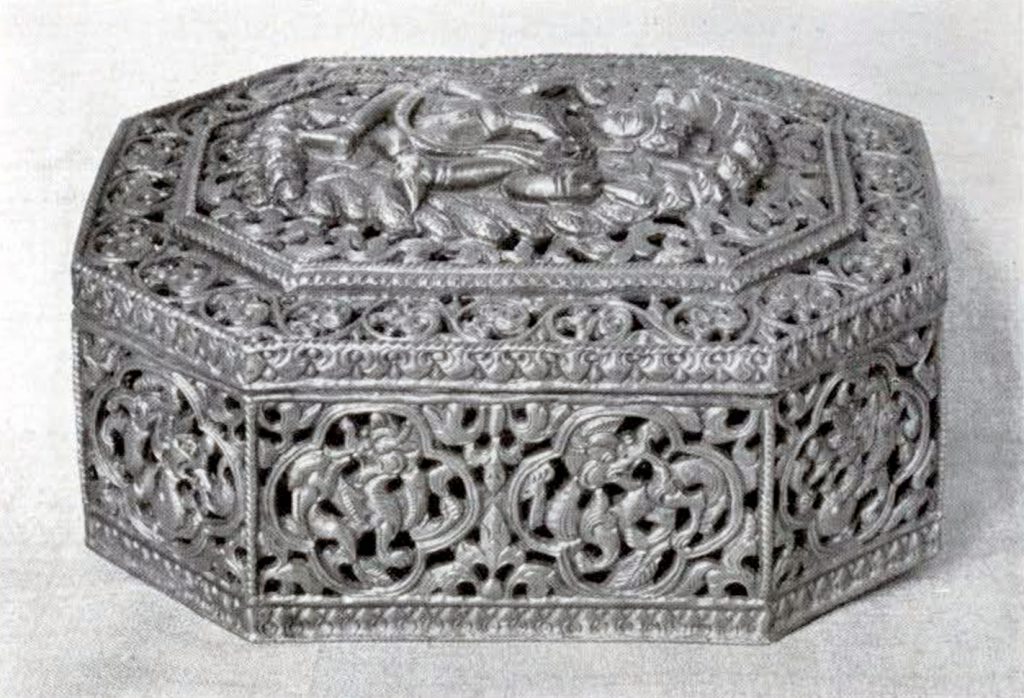
Image Number: 2187

Museum Object Numbers: A1273 / A1274
Image Number: 2200
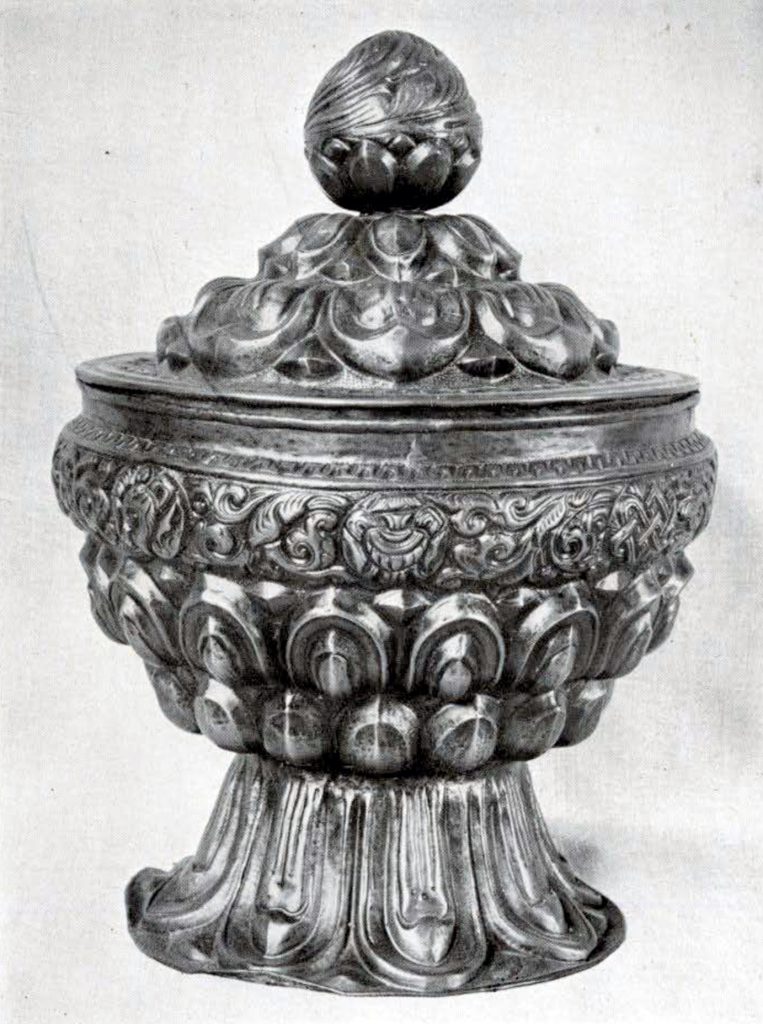
Image Number: 2191
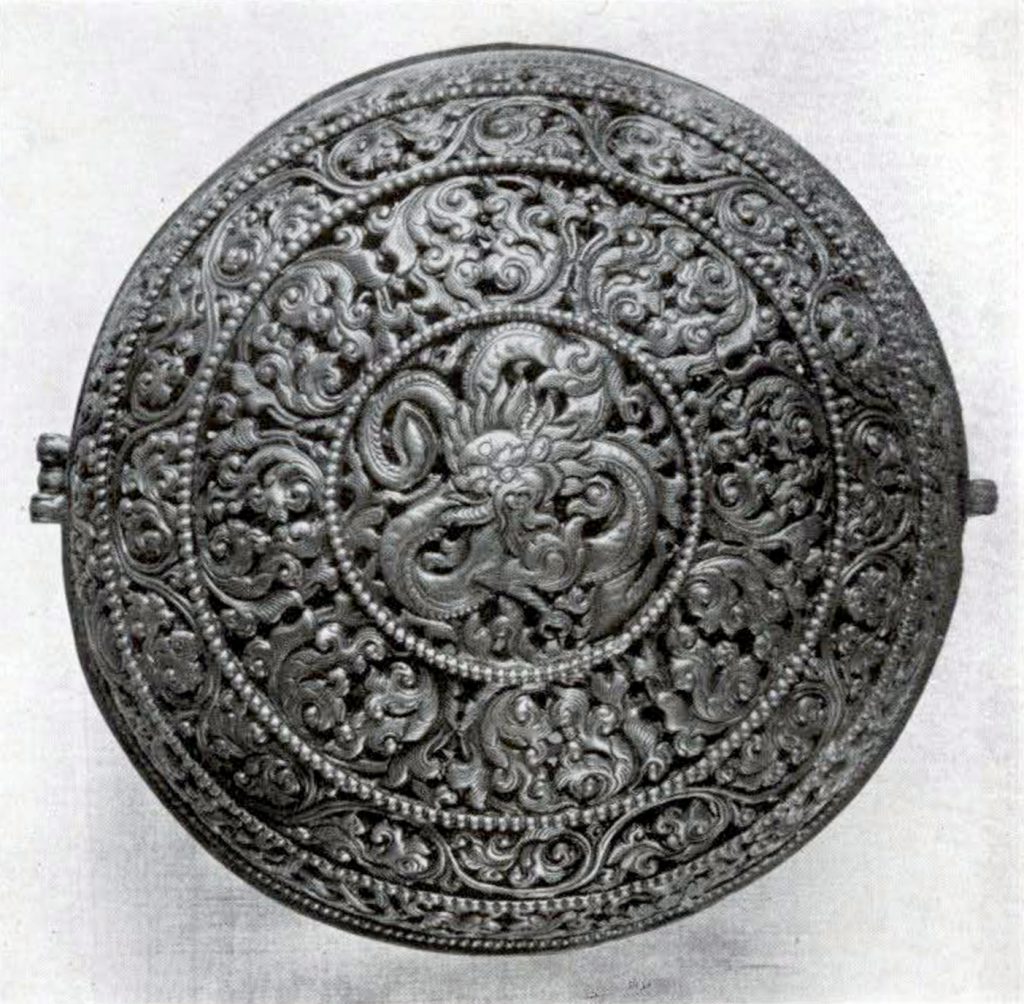
Image Number: 2192
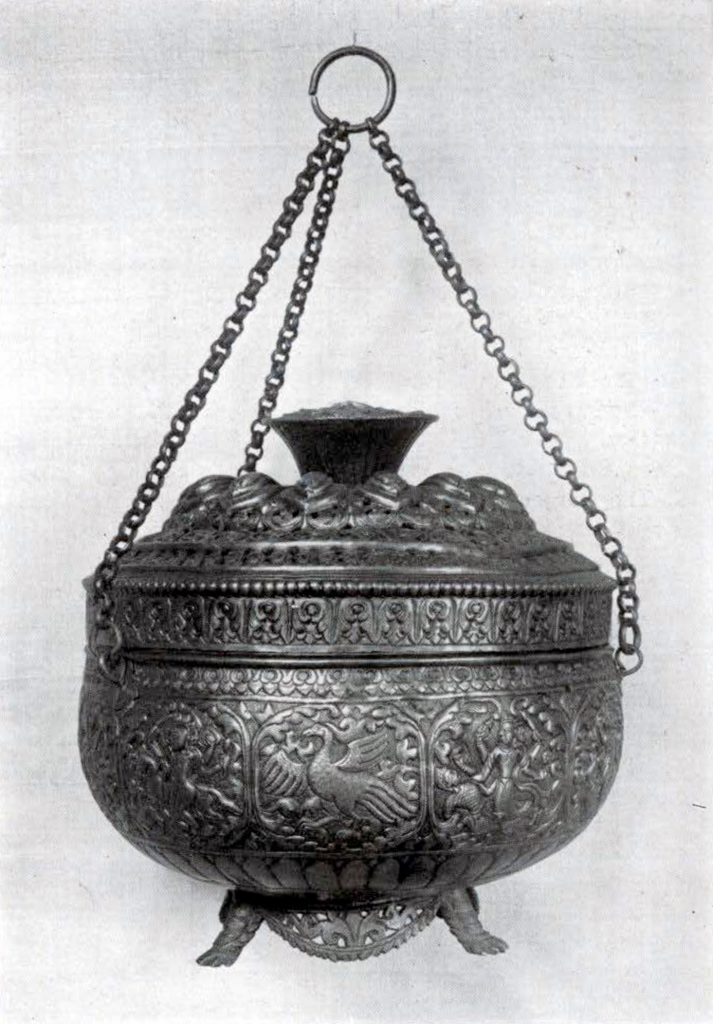
Image Number: 2193
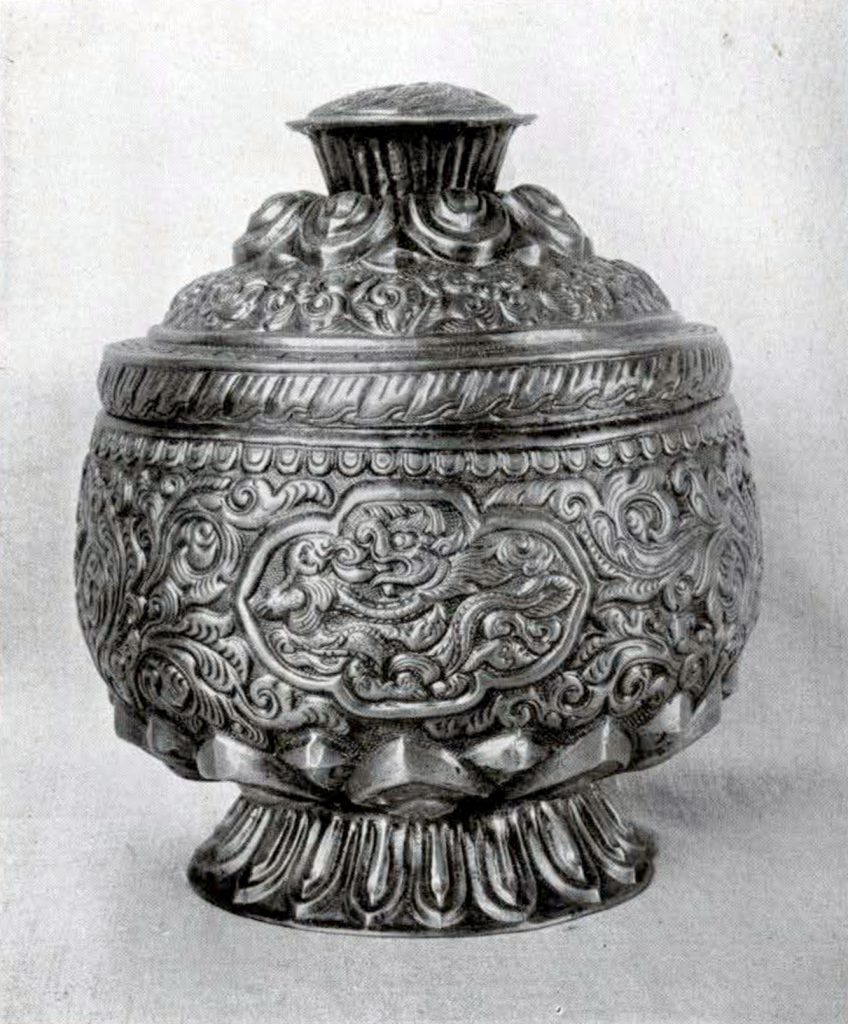
Image Number: 2194
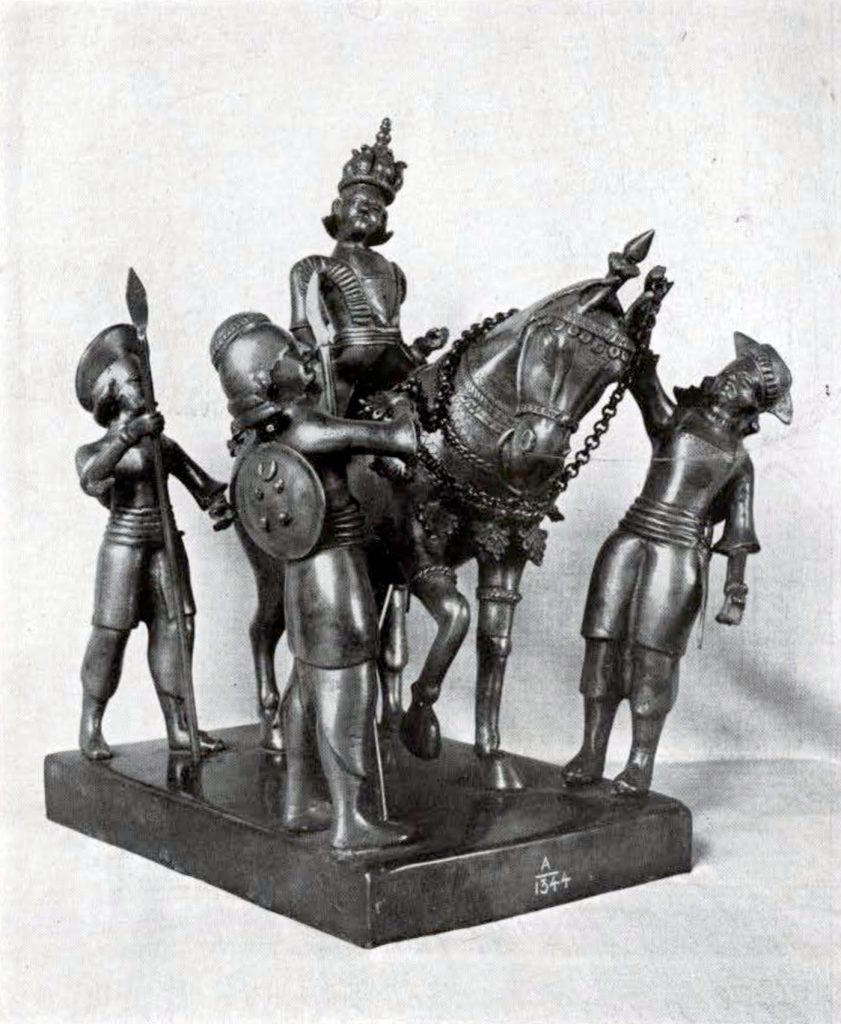
Image Number: 2318
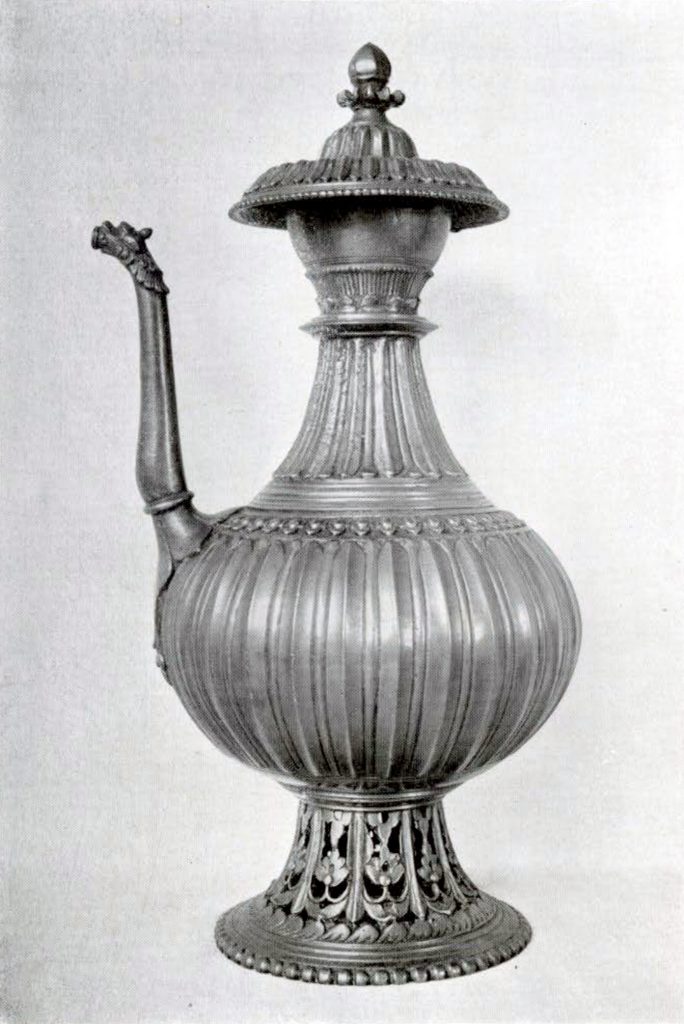
Image Number: 2202
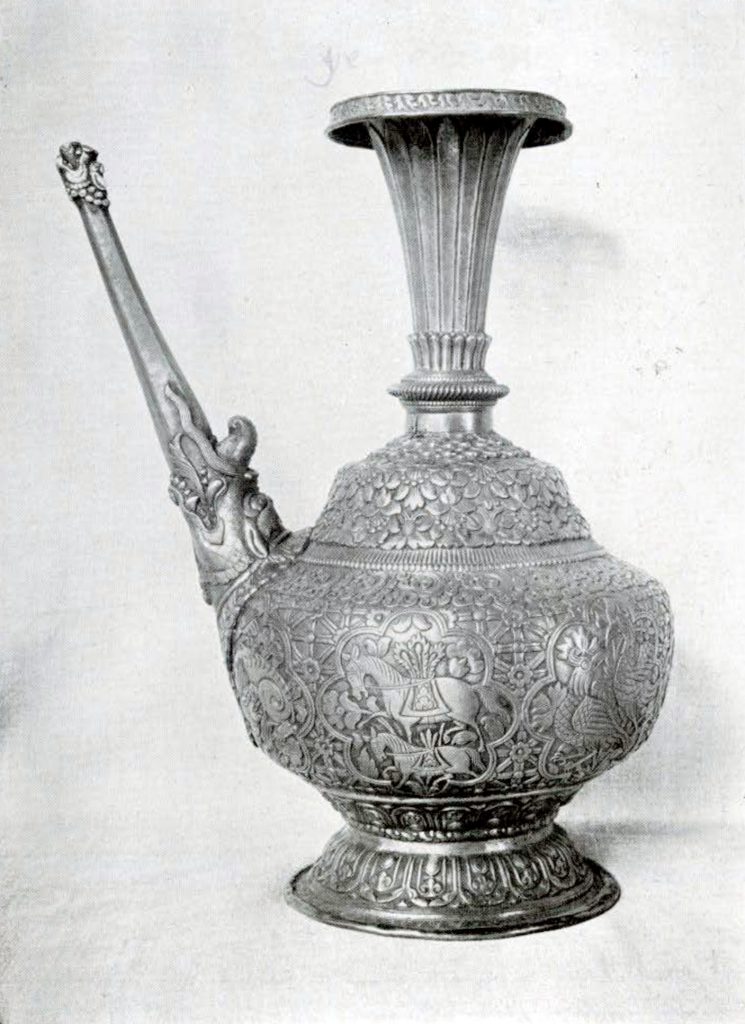
Museum Object Number: A1383
Image Number: 2203
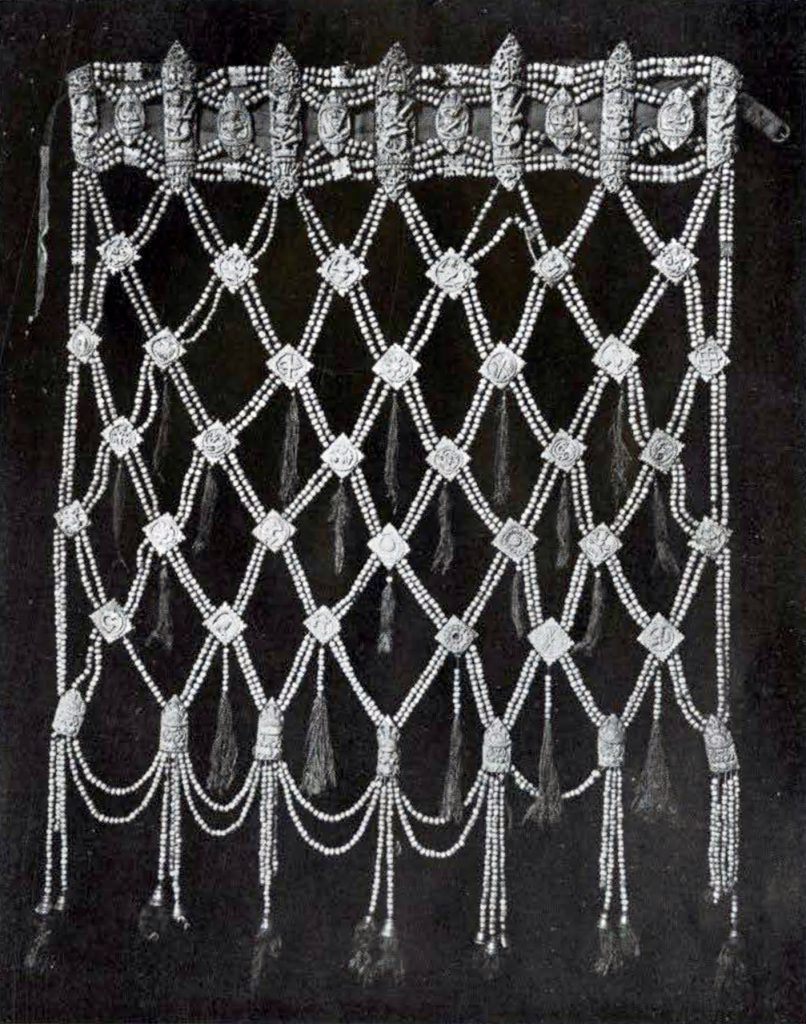
Image Number: 2186

